How Louis Armstrong Revolutionized American Music
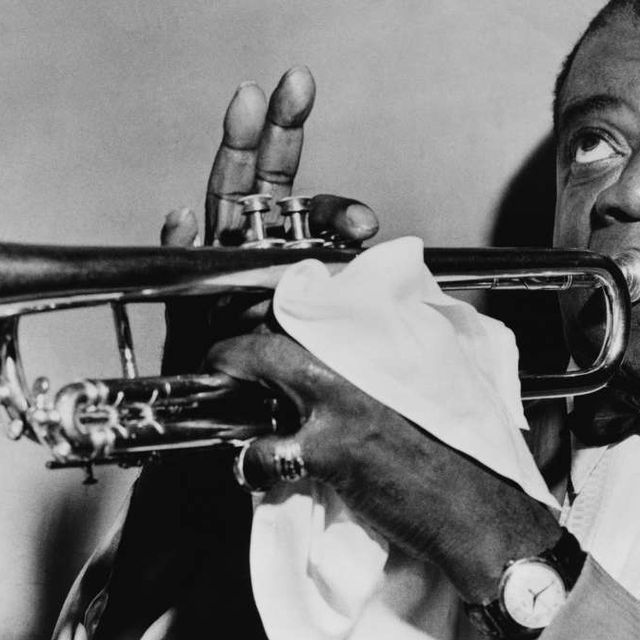

Armstrong had rough beginnings and was sent to an orphanage
Armstrong was born in a poor area of New Orleans. His mother raised him as best she could after his father abandoned the family when Armstrong was a baby. As a youth, he often sang on the streets in a vocal group for pennies. He loved hearing the many brass bands that filled the city and got excited whenever a parade was nearby. Armstrong did odd jobs for a local Jewish family that loved him and bought him his first cornet when he was 10.
On New Year's Eve of 1912, Armstrong shot a pistol in the air in celebration. He was immediately arrested and, when the court decided that his mother could not raise him properly, was sent to a Waif’s Home for orphans. Life looked bleak for the youngster but music turned out to be his salvation.
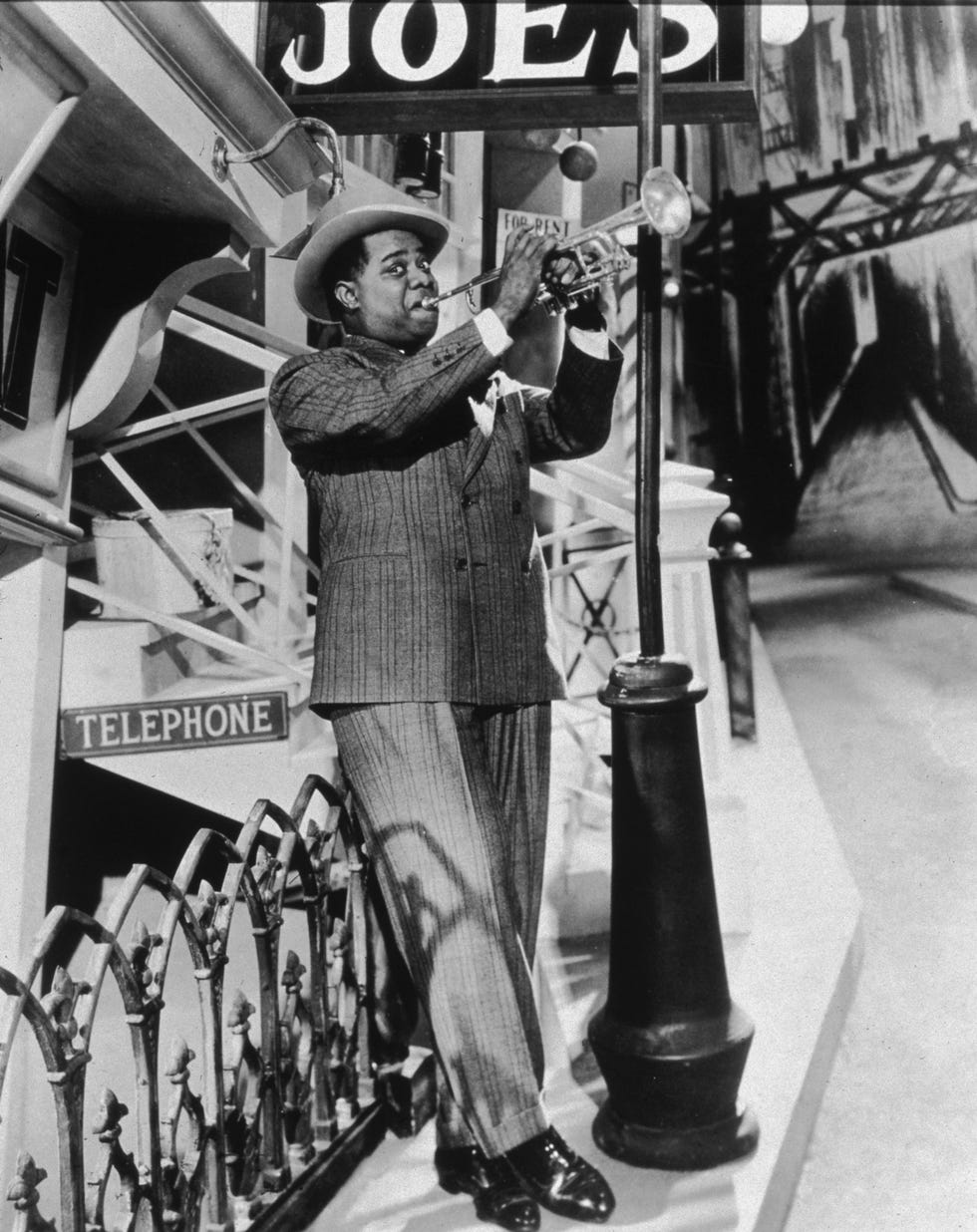
King Oliver became his mentor
The disciplined atmosphere and the Waif’s Home inspired young Armstrong to work hard on mastering the cornet. When he was released two years later, he was considered a promising musician. Armstrong idolized cornetist Joe “King” Oliver, one of New Orleans’ top musicians who became a father figure for the teenager. When Oliver moved up North in 1918, he recommended that the youngster get his spot with trombonist Kid Ory's pacesetting band. Armstrong improved rapidly, learning to read music while playing on riverboats with Fate Marable’s group. In 1922 when Oliver decided to add a second cornetist to his Creole Jazz Band, which was based at the Lincoln Gardens in Chicago, he sent for his protégé.
By then, Louis Armstrong had a beautiful tone, wide range and exciting style on the cornet. Early New Orleans jazz was primarily an ensemble-oriented music. King Oliver’s Creole Jazz Band featured four horns playing nearly all of the time, with individual heroics being largely confined to brief two or four-bar breaks and very rare one-chorus solos. Because Oliver was the lead cornetist and took care of the melody, Armstrong was mostly featured playing harmonies in ensembles, adding to the power of the group while going out of his way not to outshine its leader. However it was soon apparent to the other musicians, including pianist Lil Harden (who would soon become Armstrong’s second of four wives), that he would not be the second cornetist to anyone for long.
Armstrong changed the way jazz soloists were highlighted in the band
In 1924 Lil Armstrong persuaded her new husband to accept an offer to go to New York and join the Fletcher Henderson Orchestra. Henderson had the top Black band of the era although his orchestra, while possessing fine musicians and excellent sight-readers, had not yet learned how to swing. This is where Armstrong began to change the direction of jazz.
At the time, most jazz soloists only made brief statements, emphasizing staccato phrases, staying close to the melody and often punctuating their solos with double-time phrases that were repetitive and full of effects. At Armstrong’s first rehearsal with Henderson, the other musicians initially looked down on the newcomer because of his out-of-date clothes and rural manners. But their opinions changed as soon as Armstrong played his first notes. As a cornetist (he would switch permanently to trumpet in 1926), Armstrong’s utilized legato rather than staccato phrasing. He made every note count, used space dramatically, built up his solos to a climax and “told a story” in his playing. In addition, he put a blues feeling into every song, his expressive style was voice-like and tone was so beautiful that he helped to define the sound of the trumpet itself.
It was largely due to Armstrong's powerful playing that jazz changed into a music that put the focus on brilliant and adventurous soloists. During his year with Henderson, Armstrong became a major influence not only on other brass players but on musicians of all instruments. His swinging solos were emulated by others and, by the time he moved back to Chicago in late-1925, jazz had moved a decade ahead of where it was in 1923. Soon there were many trumpeters who sounded like relatives of Armstrong. It was not until the bebop era began twenty years later that jazz trumpeters, inspired by Dizzy Gillespie and Miles Davis , moved beyond Armstrong to look for other musical role models.
He popularized scat singing
During 1925-28, Armstrong’s recordings with his small groups (the Hot Five, Hot Seven and his Savoy Ballroom Five), revolutionized jazz, containing some of his most brilliant trumpet playing. Those timeless sessions also introduced Armstrong as a singer. Before Armstrong, most vocalists who recorded were chosen due to their volume and ability to articulate lyrics clearly, singing in a very straight and square manner. In contrast, Armstrong’s gravelly tone was distinctive from the start and he phrased like one of his horn solos. "Heebies Jeebies," from 1926, while not the very first recording of scat-singing (which utilizes nonsense syllables instead of words), greatly popularized scatting. The legend was that, after singing a chorus of the lyrics during the recording session, Armstrong dropped the music and had to make up sounds instead since he had not memorized the words, thereby inventing scat singing. It is a great story but the smoothness of Armstrong’s singing throughout the record (there is never a sense of panic) makes one think that the mishap happened on an earlier version of the song and it was decided to keep it in the routine. In any event, the first scat singing on record had already occurred 15 years earlier.
In addition to popularizing scatting, Armstrong’s relaxed phrasing in his singing, which like his trumpet playing made perfect use of space, was a revelation to other vocalists. He altered melody lines to give them catchier rhythms, and changed lyrics when it suited his voice and his conception of the song. Among those who became influenced by his phrasing while adapting it to their own musical personalities were Bing Crosby (who brought jazz phrasing into pop music), Billie Holiday , Cab Calloway and Ella Fitzgerald among countless others.
Armstrong often stole the show with his electric performances
While his small group recordings of 1925-28 made Armstrong a sensation among instrumentalists and singers, altering the course of jazz, it was in a third area that Armstrong became world famous. In 1929 he began recording regularly with a big band and was usually heard in that setting up until 1947. Rather than mostly performing jazz originals and New Orleans standards as earlier, Armstrong explored popular songs from the Great American Songbook, changing the compositions of Gershwin , Porter , Berlin , Rodgers and others into jazz through his interpretations.
As the dominant star of his performances and recordings, Armstrong was free to display his humorous personality much more. When it came to being an entertainer, Armstrong (who became universally known as “Satchmo”) was impossible to top. He could steal the show from anyone with his comedic abilities, lovable personality and musical brilliance. He became an international star, a household name who visited Europe a few times during the 1930s. When he broke up his big band in 1947, he formed a sextet called The Louis Armstrong All-Stars that made it possible economically for him to become a world traveler. His popularity grew steadily during his last 24 years and Armstrong became famous as jazz’s goodwill ambassador, even being nicknamed "Ambassador Satch." His recordings sold very well and such hits as “Blueberry Hill,” “Mack The Knife” and 1964’s “Hello Dolly” kept him famous and busy.
As the most accessible of all jazz performers and a universally beloved figure, Armstrong introduced jazz to a countless number of listeners while symbolizing the music for millions. His importance to jazz, whether through his solos, singing or ability to win over listeners, cannot be measured. The history of jazz, American music and music in general would be much different if there had not been Armstrong.
Famous Musicians
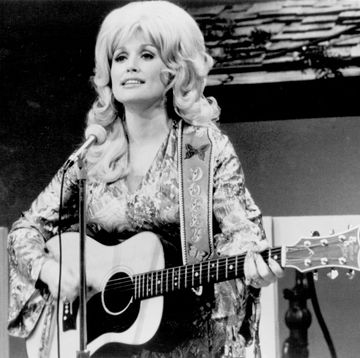
Sean “Diddy” Combs

Carrie Underwood Is Expanding Her Music Empire

Céline Dion Gives Emotional Health Update on IG

Tyler Childers

Amy Winehouse

Justin Timberlake
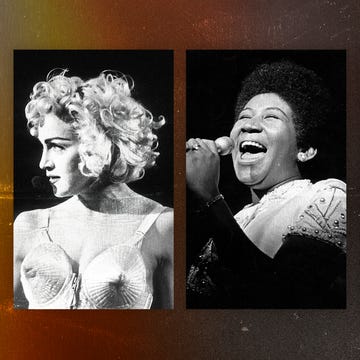
The Best Music Documentaries

10 Facts About “Need A Favor” Singer Jelly Roll

Link to Smithsonian homepage
Louis Armstrong: The First Great Jazz Soloist

Trumpet owned by Louis Armstrong, 1946, Collection of the Smithsonian National Museum of African American History and Culture
by Steven Lewis
August 4, 2016 marked the 115 th birthday of music icon Louis Armstrong. Armstrong’s immediately recognizable style and playful sense of humor helped to make him one of the single most important—if not the most important—figures in American music history. Here are three key aspects of Armstrong’s life and music.
Many scholars call Louis Armstrong the first great jazz soloist
Louis Armstrong’s improvisations permanently altered the landscape of jazz by making the improvising soloist the focal point of the performance. From the beginning of his career as a bandleader, Armstrong created ensembles to showcase his spectacular trumpet playing. His music had such an important effect on jazz history that many scholars, critics, and fans call him the first great jazz soloist. Armstrong’s influence extended far beyond jazz; the energetic, swinging rhythmic momentum of his playing was a major influence on soloists in every genre of American popular music.
In forming his distinctive playing style, Armstrong built on the influences of his earlier jazz trumpeters and also looked for more unorthodox sources of inspiration. His improvisations drew on the styles of earlier New Orleans cornet and trumpet players like Bunk Johnson, Freddie Keppard, and especially Joe “King” Oliver, who gave Armstrong informal tutoring on the instrument and eventually helped to launch his career in Chicago. But Armstrong was also inspired by the dexterity of New Orleans clarinetists and his study of classical trumpet literature, two influences that would make fluid technique and dazzling high notes into hallmarks of his style. His flashy improvisations were strikingly different from the previous generation of New Orleans trumpeters, whose solos often relied on simple melodic ideas.
Armstrong’s trumpet improvisations influenced every jazz musician who appeared after him. John Birks “Dizzy” Gillespie, one of the key architects of modern jazz, famously said “no him, no me” in reference to Armstrong, explaining that Armstrong’s playing was the foundation of his own music.
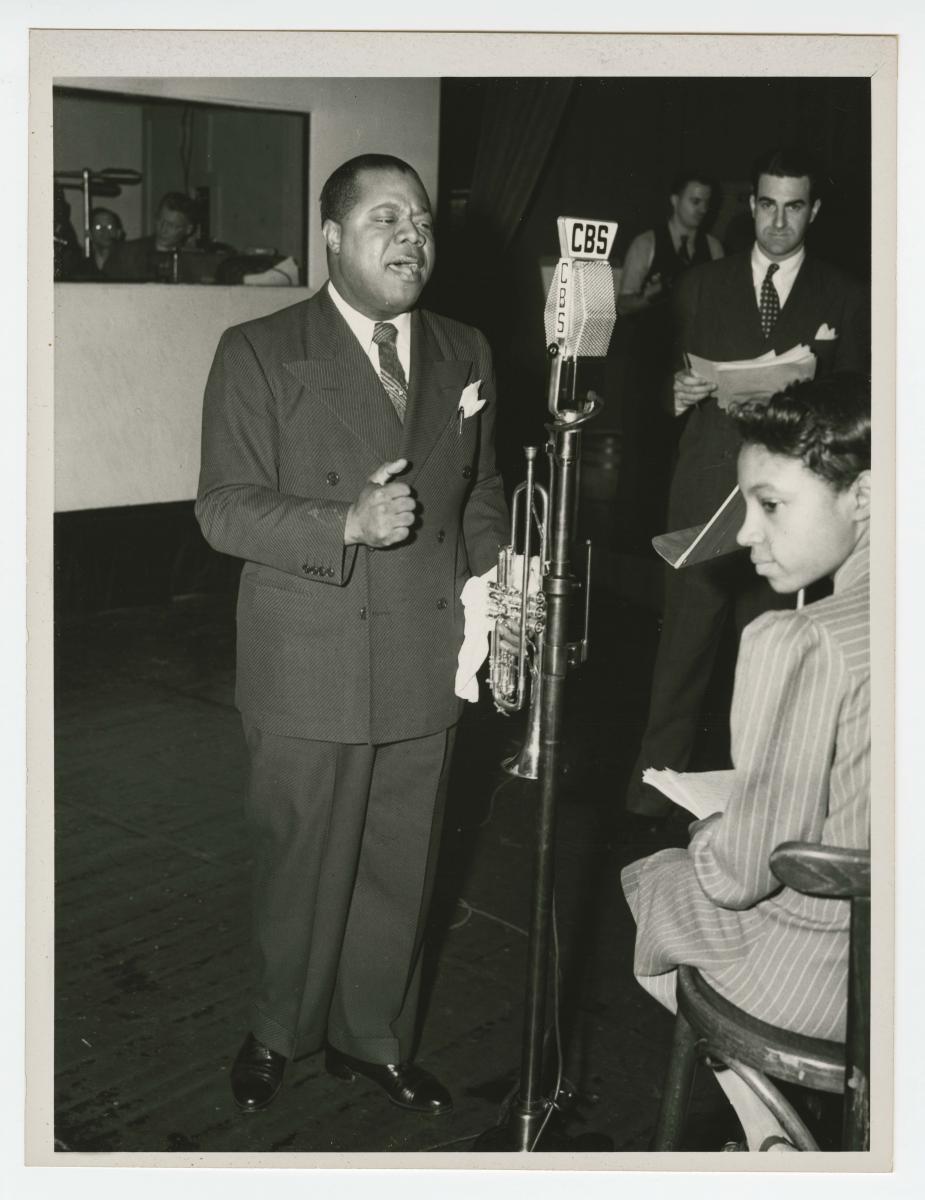
His singing was as influential as his trumpet playing
Louis Armstrong is rightly celebrated as a master jazz trumpeter, but his distinctive gravelly-voiced singing also had a huge influence on later artists. His vocal improvisations and the powerful feeling of swing that he brought to everything he sang loosened up the more formal style of his contemporaries. Where many singers would stick closely to a pop song’s original melody in performance, Armstrong felt free to introduce swinging riffs and melodic variations. In the process, he turned every song that he sang into a reflection of his own fun-loving personality.
In fact, Armstrong’s first performance experiences came as a vocalist, not as an instrumentalist. As a young boy in New Orleans, Armstrong formed a vocal quartet with his friends and performed on the street for tips. Singing remained an important part of his stage persona from the beginning of his professional career. Although Fletcher Henderson, one of Armstrong’s early employers, discouraged him from singing, Armstrong frequently featured his singing voice once he started making recordings under his own name in 1925.
Armstrong’s most influential early vocal recording is his 1926 performance of “Heebie Jeebies,” which popularized scat singing, the technique of vocal improvisation using nonsense syllables. In the later decades of his career, Armstrong came to rely more on his singing and less on flashy trumpet pyrotechnics. Some of the artists who incorporated his innovations into their own singing include Ella Fitzgerald, Billie Holiday, and Bing Crosby.
Crosby, a legendary pop singer in his own right, once called Armstrong the “greatest pop singer in the world that ever was and ever will be forever and ever,” because “when he sings a sad song you feel like crying, [and] when he sings a happy song you feel like laughing. What the hell else is there with pop singing?”
Fighting for school desegregation
In the 1950s, Armstrong used his fame to speak out in support of school desegregation.
Louis Armstrong faced increasing criticism from black music fans and fellow musicians in the years following World War II. To the new generation of politically conscious artists and activists, Armstrong’s vaudeville-inspired stage persona was reminiscent of minstrelsy. Although they admired his playing, younger jazz musicians like Dizzy Gillespie and Miles Davis expressed embarrassment at his antics. Gillespie disliked Armstrong’s open nostalgia for the South—what Gillespie called his “plantation image”—while Davis criticized Armstrong’s constant mugging and wisecracking. Their opinions reflected those of many young African Americans, who were eager to move beyond the racist stereotypes that characterized earlier depictions of black life.
Despite being widely criticized as behind the times, one of the most important moments of Armstrong’s later career came when he spoke out in support of the Civil Rights Movement. In the fall of 1957, Arkansas governor Orval Faubus deployed the Arkansas National Guard to prevent nine black students from integrating Little Rock Central High School. Faubus’s bigotry provoked national controversy, leading president Dwight Eisenhower to advise Faubus not to defy the Supreme Court’s ruling against segregation.
Frustrated with what he saw as Eisenhower’s overly cautious response to Faubus, Armstrong lashed out at the federal government, sending an angry letter to Eisenhower criticizing his decisions. Armstrong went on record calling Eisenhower “two-faced.” In protest, he cancelled his scheduled State Department tour of the Soviet Union, saying that “the way they are treating my people in the South, the government can go to hell..” “The people over there ask me what’s wrong with my country,” Armstrong continued. “What am I supposed to say?”
In criticizing the federal government’s reluctance to challenge the segregationist policies of the southern states, Armstrong joined the younger and more politically outspoken generation of jazz musicians. His voice was an important addition to the rising chorus of criticism against Jim Crow laws.
Louis Armstrong remains an icon of American history and 20 th century popular culture. His crucial contribution to American and world culture continues to reverberate into the 21 st century. Today he is revered as one of the founding geniuses of American music, and his recorded performances are studied by scholars and treasured by his fans worldwide.
Louis Armstrong’s 1946 Henri Selmer B♭ custom-made and inscribed trumpet is part of the Music and Performing Arts collection at the National Museum of African American History and Culture, opening September 24. Armstrong had been playing an earlier version of a Selmer trumpet since 1932. Although he believed you could play a trumpet for a long time, he often played his trumpets for about five years before passing them on as gifts to a friends or colleagues. Armstrong got this trumpet in February 1946, after his friend and manager Joe Glaser wrote to the Selmer Instrument Company requesting a trumpet custom-made for Armstrong. This personally inscribed trumpet is one-of-a-kind and was not mass-produced.
Steven Lewis is a PhD candidate in musicology at the University of Virginia. He is a research assistant who worked on the NMAAHC’s working on inaugural music exhibition, Musical Crossroads.
Related Features
- African American Music
- Jazz and Justice

- Plan your visit
- Group tours
- The Louis Armstrong Center
- Louis Armstrong
- Museum collections
- On-Site Research
- Digital Collections
- Virtual Exhibits
- Here To Stay
- Our Partners
- Armstrong Now
- Global Ambassadors
- Mapping Jazz and Hip-Hop in Queens
- Voices of Freedom
Louis Armstrong was born in a poor section of New Orleans known as “the Battlefield” on August 4, 1901.
By the time of his death in 1971, the man known around the world as Satchmo was widely recognized as a founding father of jazz—a uniquely American art form. His influence as an artist and cultural icon is universal, unmatched, and very much alive today.
Satchmo’s Achievements
Louis Armstrong’s achievements are remarkable. During his career, he:
- Developed a way of playing jazz, as an instrumentalist and a vocalist, which has had an impact on all musicians to follow;
- Recorded hit songs for five decades, and his music is still heard today on television and radio and in films;
- Wrote two autobiographies, more than ten magazine articles, hundreds of pages of memoirs, and thousands of letters;
- Appeared in more than thirty films (over twenty were full-length features) as a gifted actor with superb comic timing and an unabashed joy of life;
- Composed dozens of songs that have become jazz standards;
- Performed an average of 300 concerts each year, with his frequent tours to all parts of the world earning him the nickname “Ambassador Satch,” and became one of the first great celebrities of the twentieth century.
Entertaining Millions
Through the years, Louis entertained millions, from heads of state and royalty to the kids on his stoop in Corona. Despite his fame, he remained a humble man and lived a simple life in a working-class neighborhood. To this day, everyone loves Louis Armstrong—just the mention of his name makes people smile.
Read Louis’ Bio
Sounds of Satchmo
The bottom line of any country in the world is ‘What did we contribute to the world?’ We contributed Louis Armstrong
Tony Bennett
Biography of Louis Armstrong, Expert Trumpeter and Entertainer
Armstrong played a key role in the development of jazz
William Gottlieb / Getty Images
- People & Events
- Fads & Fashions
- Early 20th Century
- American History
- African American History
- African History
- Ancient History and Culture
- Asian History
- European History
- Latin American History
- Medieval & Renaissance History
- Military History
- Women's History
Working on the Streets
- The Colored Waif's Home
Becoming a Musician
Leaving new orleans, armstrong earns a reputation.
- 'The World's Greatest Trumpet Player'
The Great Depression
Big changes, louis and the all-stars, controversy and racial tension, criticized by black americans, later years and death, additional references.
- B.A., English Literature, University of Houston
Louis Armstrong (August 4, 1901–July 6, 1971) was a masterful trumpet player and beloved entertainer in the 20th century. He rose above the hardship and challenges of poverty from a young age and the racism he was subjected to throughout his life to become one of the most influential musicians of his genre.
He played a key role in the development of one of the early 20th century's most important new styles of music: jazz. Though he mostly kept quiet about racial discrimination, much to the disapproval of fellow Black Americans, Armstrong sparked controversy when he spoke out publicly against segregation in Little Rock, Arkansas, in 1957.
Armstrong's inventiveness and improvisational techniques—along with his energetic, dazzling style—have influenced generations of musicians. One of the first to perform scat-style singing, he is also well-known for his distinctive, gravelly singing voice. Armstrong wrote two autobiographies, becoming the first Black jazz musician to write an autobiography, and appeared in more than 30 films.
Fast Facts: Louis Armstrong
- Known For : World-famous trumpeter and entertainer; he was influential in the development of jazz and also appeared in more than 30 movies
- Also Known As : Satchmo, Ambassador Satch
- Born : August 4, 1901, in New Orleans
- Parents : Mary Ann, William Armstrong
- Died : July 6, 1971, in New York City
- Top Albums : "Ella and Louis," "New Orleans Nights," "Satchmo Musical Autobiography," "Under the Stars," "Porgy and Bess," "I’ve Got the World on a String"
- Awards and Honors : 1964 Grammy for Best Male Vocal Performance ("Hello Dolly"), Grammy Hall of Fame (various years), Rock and Roll Hall of Fame (inducted 2019)
- Spouses : Daisy Parker (m. 1918–1923), Lili Hardin Armstrong (m. 1924–1938), Alpha Smith (m. 1938–1942), Lucille Wilson (m. 1942–1971)
- Notable Quote : "If you have to ask what jazz is, you'll never know."
Louis Armstrong was born in New Orleans on August 4, 1901, to 16-year-old Mary Ann Albert and her boyfriend Willie Armstrong. Willie left Mary Ann only weeks after Louis' birth, and Louis was placed in the care of his grandmother, Josephine Armstrong.
Josephine brought in some money doing laundry for White families but struggled to keep food on the table because she was paid little money for her work. Young Louis had no toys, very few clothes, and went barefoot most of the time. Despite their hardships, Josephine made sure her grandson attended school and church.
While Louis was living with his grandmother, his mother briefly reunited with Willie Armstrong and gave birth to a second child, Beatrice, in 1903. While Beatrice was still very young, Willie once again left Mary Ann.
Four years later, when Armstrong was 6 years old, he moved back in with his mother, who was then living in a highly dangerous neighborhood, a red-light district called Storyville. Because Armstrong was young during this period, not much is known about his mother's situation and why she lived there, but Black women, especially single mothers, were heavily discriminated against at the time.
When recounting his mother's occupation, Armstrong confessed that he did not know whether his mother was a sex worker, an occupation that he referred to as "hustling," or not because she "kept it out of sight." He only knew that they were poor. Nonetheless, it became Louis’ job to look after his sister while his mother worked.
Apic / Getty Images
By the age of 7, Armstrong was looking for work wherever he could find it. He sold newspapers and vegetables and made a little money singing on the street with a group of friends. Each group member had a nickname; Louis was known as "Satchelmouth" (later shortened to "Satchmo"), a reference to his wide grin.
Armstrong saved up enough money to buy a used cornet (a brass musical instrument similar to a trumpet), which he taught himself to play. He quit school at age 11 to concentrate on earning money for his family, as was common for children from poor backgrounds at this time.
While performing on the street, Armstrong and his friends came into contact with local musicians, many of whom played in Storyville honky-tonks (bars with working-class patrons, often found in the South).
Armstrong was befriended by one of the city's best-known trumpeters, Bunk Johnson, a fellow Black performer who taught him songs and new techniques and allowed Louis to sit in with him during performances in the honky-tonks.
An incident on New Year's Eve in 1912 changed the course of Armstrong's life.
The Colored Waif's Home
During a New Year's Eve street celebration at the end of 1912, 11-year-old Louis fired a pistol into the air. He was taken to the police station and spent the night in a cell. The next morning, a judge sentenced him to the Colored Waif's Home for an unspecified period of time. At this time, Black juvenile offenders were often given harsh prison sentences while White juvenile offenders were sentenced to time in reformatory homes for equal crimes. It is often the case still today that Black people and people of color receive harsher sentences than White people. The Waif's Home made Armstrong's lesser sentence possible in a period when the justice system exercised strong bias against Black Americans.
The home, a reformatory for Black youths, was operated by a former soldier, Captain Jones. Jones was a strict disciplinarian dedicated to reducing juvenile delinquency in Black boys who "never had a chance." Records indicate that he and his wife took on parental roles for many of the boys. A Black man himself, Jones advocated for Black boys who were arrested to be placed in a reformatory home—designed specifically for Black juveniles—rather than thrown in jails with adult criminals. He wanted to give incarcerated Black boys an opportunity to rise above unfair treatment and not become the criminals that the judicial system already perceived them to be.
Due to the structure and opportunities that Armstrong received there, Jones and his home had an overall positive effect on him. Of the home, Armstrong said: "It sure was the greatest thing that ever happened to me. Me and music got married in the Home...The place seemed more like a health center, or a boarding school, than a boys' jail."
Eager to participate in the home's brass band, Armstrong was disappointed when he was not allowed to join right away. Director of music Peter Davis was initially hesitant to allow a boy who had fired a gun to join his band. However, Armstrong eventually convinced him and worked his way up the ranks. He first sang in the choir and later was assigned to play various instruments, eventually taking over the cornet. Having demonstrated his willingness to work hard and act responsibly, Louis was made the leader of the band. He reveled in this role.
The home's music program played an especially large role in the direction Armstrong's life would take from there. Davis, in particular, influenced young Armstrong greatly. He saw the raw talent the boy possessed and was persistent in nurturing him into the skilled musician he would become. According to Dr. Robert S. Mikell of The Syncopated Times , when the two reunited years later, Davis' pride and Armstrong's gratitude were palpable to onlookers.
In 1914, after 18 months at the Colored Waif's Home, Armstrong returned home to his mother.
Back home, Armstrong delivered coal during the day and spent his nights in local dance halls listening to music. He became friends with Joe "King" Oliver, a leading cornet player, and ran errands for him in return for cornet lessons.
Armstrong learned quickly and began to develop his own style. He filled in for Oliver at gigs and gained further experience playing in parades and funeral marches.
When the U.S. entered World War I in 1917, Armstrong was too young to be drafted, but the war did indirectly affect him. When several sailors stationed in New Orleans became victims of violent crime in the Storyville district, the secretary of the Navy shut down the district, including brothels and clubs. While a large number of musicians from New Orleans moved north, many relocating to Chicago, Armstrong stayed and soon found himself in demand as a cornet player.
By 1918, Armstrong had become well-known on the New Orleans music circuit, playing at numerous venues. That year, he met and married Daisy Parker, a sex worker who worked in one of the clubs he played in.
Impressed by Armstrong's natural talent, band conductor Fate Marable hired him to play in his riverboat band on excursions up and down the Mississippi River. Though disappointed to see him go, Daisy understood that this was a good move for his career and supported him.
Armstrong played on the riverboats for three years. The discipline and high standards that he was held to made him a better musician; he also learned to read music for the first time. Yet, chafing under Marable's strict rules, Armstrong grew restless. He yearned to strike out on his own and find his unique style.
Armstrong quit the band in 1921 and returned to New Orleans. He and Daisy divorced that year.
In 1922, a year after Armstrong quit the riverboats, King Oliver asked him to come to Chicago and join his Creole Jazz Band. Armstrong played the second cornet and was careful not to outshine bandleader Oliver.
Through Oliver, Armstrong met Lil Hardin , a classically trained jazz pianist from Memphis and the second woman he would marry.
Lil recognized Armstrong's talent and thus urged him to break away from Oliver's band. After two years with Oliver, Armstrong quit the band and took a new job with another Chicago band, this time as the first trumpet; however, he only stayed a few months.
Armstrong moved to New York City in 1924 at the invitation of bandleader Fletcher Henderson . (Lil did not accompany him, preferring to stay at her job in Chicago.) The band played mostly live gigs but made recordings as well. They played backup for pioneering blues singers such as Ma Rainey and Bessie Smith, furthering Armstrong's growth as a performer.
Just 14 months later, Armstrong moved back to Chicago at Lil's urging; Lil believed that Henderson held back Armstrong's creativity.
'The World's Greatest Trumpet Player'
Lil helped to promote Armstrong in Chicago clubs billing him as "the world's greatest trumpet player." She and Armstrong formed a studio band, called Louis Armstrong and His Hot Five. The group recorded several popular records, many of which featured Armstrong's raspy singing.
On one of the most popular of the recordings, "Heebie Jeebies," Armstrong spontaneously launched into scat-singing, in which the singer replaces the actual lyrics with nonsense syllables that often mimic the sounds made by instruments. Armstrong did not invent the singing style but helped to make it enormously popular.
During this time, Armstrong permanently switched from cornet to trumpet, preferring the brighter sound of the trumpet to the more mellow cornet.
The records gave Armstrong name recognition outside of Chicago. He returned to New York in 1929, but again, Lil did not want to leave Chicago. (They stayed married but lived apart for many years before divorcing in 1938.)
In New York, Armstrong found a new venue for his talents. He was cast in a musical revue that featured the hit song "Ain't Misbehavin'" and Armstrong's accompanying trumpet solo. Armstrong displayed showmanship and charisma, gaining a greater following after the show.
Because of the Great Depression , Armstrong, like many other Americans and especially Black Americans, had trouble finding work. In 1932, approximately one half of Black Americans were unemployed, some fired from their jobs simply because White Americans were out of work. Armstrong decided to make a new start in Los Angeles, moving there in May 1930. He found work in clubs and continued to make records.
He made his first film, "Ex-Flame," appearing as himself in the movie in a small role. Armstrong gained more fans through this widespread exposure. After an arrest for marijuana possession in November 1930, Armstrong received a suspended sentence and returned to Chicago.
According to writer Marco Medic, it is widely believed that the police officers responsible for his arrest were fans of his and that this played a role in his receiving a lighter sentence even though marijuana-related crimes were harshly punished across the board during this time. Some also speculate that higher-ups in the music industry had something to do with securing Armstrong a suspended sentence, though none of this is documented. Despite his arrest, he stayed afloat during the Depression, touring the U.S. and Europe from 1931 to 1935.
Armstrong continued to tour throughout the 1930s and 1940s and appeared in a few more movies. He became well-known not only in the U.S. but in much of Europe as well, even playing a command performance for King George V of England in 1932.
John Springer Collection / Getty Images
In the late 1930s, band leaders such as Duke Ellington and Benny Goodman helped to propel jazz into the mainstream, ushering in the swing music era. The swing bands were large, consisting of about 15 musicians. Although Armstrong preferred working with smaller, more intimate ensembles, he formed a large band in order to capitalize on the swing movement.
In 1938, Armstrong married longtime girlfriend Alpha Smith, but soon after the wedding he began seeing Lucille Wilson, a dancer from the Cotton Club. Marriage No. 3 ended in divorce in 1942 and Armstrong married Lucille, his fourth (and final) wife, the same year.
While Armstrong toured, often playing at military bases and army hospitals during World War II , Lucille found them a house in her hometown of Queens, New York. After years of traveling and staying in hotel rooms, Armstrong finally had a permanent home.
John Kisch Archive / Getty Images
In the late 1940s, large bands were falling out of favor, deemed too expensive to maintain. Armstrong formed a six-piece group called Louis Armstrong and the All-Stars. The group debuted at New York's Town Hall in 1947, playing New Orleans-style jazz to rave reviews.
Not everyone enjoyed Armstrong's somewhat "hammy" brand of entertainment. Many from the younger generation considered him a relic of the Old South and found his mugging and eye-rolling racially offensive because it was too similar to the performance of a minstrel in blackface.
Some experts see his performance style as a declaration and celebration of Black culture. Others, however, wonder whether he was just giving White people the entertainment he knew they wanted by presenting himself, a Black man, as clownish. Whatever the case, these characteristics became a lasting part of his persona and he was not taken seriously by young up-and-coming jazz musicians. Armstrong, however, saw his role as more than that of a musician: he was an entertainer.
Armstrong made 11 more movies in the 1950s. He toured Japan and Africa with the All-Stars and recorded his first singles. Soon he attracted even more attention, but this time not for his music.
Armstrong faced criticism in 1957 for speaking out against racial discrimination during the event in Little Rock, Arkansas , in which Black students were threatened and attacked by hateful White people while attempting to enter what should have been a newly integrated school. Upon hearing of this, Armstrong, then performing internationally for the State Department, canceled the Soviet Union leg of his tour.
During this time, the State Department was sending famous musicians, Black and White, overseas to perform together. This was supposed to give the illusion of the U.S. as a superior, peaceful nation built on democracy, freedom, and equality. This "cultural diplomacy" effort was organized in order to win favor in communist countries and areas during the Cold War, and the U.S. was strategically using jazz and jazz musicians for good press and as a symbol of American democracy.
Armstrong's refusal to play in the USSR was done in protest of the U.S. government; specifically, President Dwight D. Eisenhower, who refused to do anything to help the Black students safely attend the school, and Arkansas Gov. Orval Faubus, who continued to support keeping the Black students out. Armstrong, outraged and tired of being cooperative when Black people were suffering, was no longer willing to pretend that conditions in the U.S. were anything close to favorable for Black Americans, as the U.S. government would have other countries believe.
After he canceled his tour in the Soviet Union and went back to playing U.S. shows with the All-Stars, Armstrong did an interview with Larry Lubenow of the Grand Forks Herald, during which he unexpectedly shared many instances of racial discrimination he'd experienced when performing in the South.
Bettmann / Getty Images
In reference to the situation in Little Rock, he was recorded saying, "The way they are treating my people in the South, the government can go to hell." He also sang an expletive-ridden version of "The Star-Spangled Banner," though this never made it on the air, and made his distaste of the government even more clear when he called the president "two-faced" and Faubus an "ignorant plowboy." This type of action was rare for Armstrong, who often said, "I don't get involved in politics. I just blow my horn."
Following this bold stand, some radio stations refused to play Armstrong's music. Other Black entertainers that used to support Armstrong turned against him for overtly challenging the status quo because they were worried that he was risking undoing the progress Black Americans had made in society. The controversy, however, mostly faded after Eisenhower finally sent the National Guard to Little Rock to facilitate integration and escort the students into the school. Many historians feel that Armstrong was partially responsible for this decision.
But before bravely protesting segregation and the president's inaction in Little Rock, Armstrong was criticized by Black people for not doing enough. Some Black people at the time hated that his quiet and submissive demeanor tended to placate White people and make them feel more comfortable with Black Americans.
White people saw him as a contradictory member of the Black community and liked that he was reserved, respectful, and didn't ask for anything or cause problems for them. Many Black people, though, felt that Armstrong should be more outspoken about the horrors that Black Americans were facing and challenge White Americans rather than put them at ease. He was seen by many as "old-fashioned," and this wasn't a good thing.
Indeed, Armstrong mostly kept his thoughts about racism in America to himself. He was not known to take political stances when performing and he went along with being a "diplomatic ambassador" for the U.S. for a while. Until Little Rock, only those in Armstrong's close circle knew how he felt about politics and discrimination in America.
Shortly after his historic and controversial public outcry against the government, Armstrong's health began to sharply decline. On tour in Italy in 1959, he suffered a massive heart attack. After a week in the hospital, he flew back home. Despite warnings from physicians, Armstrong returned to a busy schedule of live performances.
After playing five decades without a No. 1 song, Armstrong finally made it to the top of the charts in 1964 with "Hello Dolly," the theme song for the Broadway play of the same name. The popular song knocked the Beatles from the top spot they had held for 14 consecutive weeks.
Armstrong was not involved much in civil rights after 1957. However, some experts believe that he might have been making a statement when in 1929 he first recorded "Black and Blue," a hit composed by Fats Waller, for the musical "Hot Chocolates" by Edith Wilson. The lyrics to this song have been said to represent the plight of Black Americans, who were scorned, heavily discriminated against, and beaten (until they were black and blue with bruises) for the color of their skin:
"I'm white—inside—but that don't help my case 'Cause I can't hide what is in my face ... My only sin is in my skin What did I do to be so black and blue?"
By the late 1960s, Armstrong was still able to perform, despite kidney and heart problems. In the spring of 1971, he suffered another heart attack. Unable to recover, Armstrong died July 6, 1971, at age 69.
More than 25,000 mourners visited the body of Louis Armstrong as it lay in state and his funeral was televised nationally.
- Anderson, Gene H. " Louis Armstrong. " Richmond School of Arts & Sciences, 2013.
- “ Bop to the Best of Louis Armstrong | UDiscover Music .” UDiscoverMusic.
- Buckingham, William D. " Louis Armstrong and the Waifs' Home. " The Jazz Archivist , vol. XXIV, 2011. Tulane University.
- " Great Depression and World War II, 1929-1945. " Library of Congress.
- “ Louis Armstrong - Awards and Honors .” JazzSkool.org.
- McWhorter, John. " Louis Armstrong's Underrated Legacy. " The Entertainer , 14 Dec. 2009.
- Medic, Marco. " Louis Armstrong and Marijuana - The Famous Trumpeter Loved His Weed. " Greencamp. 7 Nov. 2017.
- Mikell, Dr. Robert S. " The Legacy of Louis Armstrong's Music Teacher Peter Davis. " The Syncopated Times . 27 July 2019.
- " 'Pops': Louis Armstrong, In His Own Words. " National Public Radio, 2 Dec. 2009.
- " Revisiting Louis Armstrong in the Context of Civil Rights. " National Public Radio, 22 Nov. 2006.
“ Demographic Differences in Sentencing .” United States Sentencing Commission, Nov. 2017.
- Black History Timeline: 1920–1929
- Black History Timeline: 1930–1939
- Black History from 1950–1959
- Biography of Lil Hardin Armstrong, Early Jazz Instrumentalist
- Important Cities in Black History
- Black History Timeline: 1890–1899
- Black History and Women's Timeline: 1920-1929
- Biography of Booker T. Washington, Early Black Leader and Educator
- The Life and Times of Dr. Ronald E. McNair
- Nina Simone: The Life and Music of the "Priestess of Soul"
- The Setting of 'A Streetcar Named Desire'
- Jackie Robinson
- Biography of Dr. Carter G. Woodson, Black Historian
- Biography of the Rev. Dr. Martin Luther King Jr., Civil Rights Leader
- Biography of Elvis Presley, the King of Rock 'n' Roll
- Black History Timeline: 1965–1969
- Subject List
- Take a Tour
- For Authors
- Subscriber Services
- Publications
- African American Studies
- African Studies
- American Literature
- Anthropology
- Architecture Planning and Preservation
- Art History
- Atlantic History
- Biblical Studies
- British and Irish Literature
- Childhood Studies
- Chinese Studies
- Cinema and Media Studies
- Communication
- Criminology
- Environmental Science
- Evolutionary Biology
- International Law
- International Relations
- Islamic Studies
- Jewish Studies
- Latin American Studies
- Latino Studies
- Linguistics
- Literary and Critical Theory
- Medieval Studies
- Military History
- Political Science
- Public Health
- Renaissance and Reformation
- Social Work
- Urban Studies
- Victorian Literature
- Browse All Subjects
How to Subscribe
- Free Trials
In This Article Expand or collapse the "in this article" section Louis Armstrong
Introduction.
- Textbook Chapters
- Reference Works
- Biographical Surveys
- Comprehensive Biographies
- Historical Topics
- Ethnographic Studies
- Iconography
- In His Own Words
- Source Readings
- Oral History and Interviews with Contemporaries
- Musical Scores
- Lead Sheets
- Criticism of Armstrong’s Recordings
- Criticism of Armstrong’s Singing
- Book-length Studies
- Articles and Book Chapters
- Style Analysis of Vocal Performance
- Performance Practice/Pedagogy
- Commentary on Armstrong’s Film Acting
- Commentary on Armstrong’s Writings and Other Verbal Output
- Commentary on Armstrong’s Artwork
- Historiography
Related Articles Expand or collapse the "related articles" section about
About related articles close popup.
Lorem Ipsum Sit Dolor Amet
Vestibulum ante ipsum primis in faucibus orci luctus et ultrices posuere cubilia Curae; Aliquam ligula odio, euismod ut aliquam et, vestibulum nec risus. Nulla viverra, arcu et iaculis consequat, justo diam ornare tellus, semper ultrices tellus nunc eu tellus.
- Edward Kennedy "Duke" Ellington
Other Subject Areas
Forthcoming articles expand or collapse the "forthcoming articles" section.
- 19th-Century Music Criticism
- Hip Hop in Africa
- Find more forthcoming articles...
- Export Citations
- Share This Facebook LinkedIn Twitter
Louis Armstrong by William Bauer LAST MODIFIED: 28 March 2018 DOI: 10.1093/obo/9780199757824-0240
A towering figure in cultural history, Louis Armstrong transformed music and society. His contributions as jazz trumpeter and singer, actor and comedian, composer and bandleader, and author and international celebrity continue to resonate. As the first African American artist to achieve nationwide stardom in the entertainment industry, Armstrong used his celebrity and immense musical gifts to bridge racial divisions in American society, opening doors for other African American performers to follow in his footsteps. Born into severe poverty on 4 August 1901, Armstrong attained artistic and commercial success in a career spanning more than fifty years. He worked in a variety of media—mainly music but also radio, film, print, and collage—sustaining a grueling performance schedule and producing hundreds of recorded tracks, many now canonical. In his published and unpublished autobiographies, essays, and innumerable letters, he left a substantial body of written work that reveals the multifaceted scope of his genius. Taken as a whole, his creative output speaks in a deeply personal voice of the human condition in all its complexity, transcending boundaries of time, place, ethnicity, and culture while also grounding his expression in his African American identity. Growing up in culturally and ethnically rich New Orleans, Armstrong absorbed a wide variety of musical styles, including “coon” songs, piano rags, brass band marches, opera and especially the blues. After making his presence felt in the budding Chicago and New York jazz scenes, he led a series of landmark 1920s recordings known as the “Hot Fives and Hot Sevens,” which hold a seminal place in the jazz literature. The unique style and sheer exuberance bursting forth from these and later discs set a standard for future generations of jazz musicians and popular entertainers—urging, inspiring, daring them to surpass it. His immediately recognizable sound, expressive range, ironic wit, and breathtaking abundance of ideas played a formative role in the emerging Swing Era style. His uncanny ability to harness the technological advancements of his day—in sound recording, radio broadcasting, cinema, and, later, television—further propelled his ideas into the popular imagination. Nowadays we take for granted that a jazz soloist will unleash his or her creativity in virtuosic feats of melodic invention. Armstrong convincingly demonstrated the idiom’s potential for such freedom of expression early in its development, leaving his indelible mark on the many songs he interpreted throughout his career, as well as on musicians of all persuasions and on the many lives he touched. Long after his death on 6 July 1971 his exemplary achievements continue to reverberate throughout the world.
General Overviews
The following sources offer broad portraits of Armstrong’s life and career, and typically provide critical appraisal of his musical contributions. The most recent sources benefit from information that surfaced after the opening of the Louis Armstrong House Museum in 1991. As co-editor of Louis Armstrong: A Cultural Legacy ( Miller 1994 ) (and curator of the Queens Museum of Art’s exhibit for which the volume served as catalogue), Marc Miller had a wealth of pictorial detail at his fingertips to supplement his essays (see under Iconography see also “Louis Armstrong: A Portrait Record” in Miller 1994 ). Among these general works, Anderson 2013 gives readers the most detail. Cogswell 2003 provides many fresh insights, informed by the author’s role as executive director of the Louis Armstrong House Museum. Cogswell 2002 effectively updates prior entries in both the New Grove Dictionary of Jazz and New Grove Dictionary of Music and Musicians . Giddins 1998 , Morgenstern 2000 , and Harker 2004 effectively condense commentary that each author set forth in more expansive work cited elsewhere in this bibliography. Wagstaff 2007 , originally published in 1981, is still worth ferreting out for its astute biographical sketch and style analysis. A subsection focuses on general overviews found in textbooks.
Anderson, Gene H. Louis Armstrong: Grove Music Essentials . The Grove Dictionary of Music . 2d ed. Oxford and New York: Oxford University Press, 2013.
DOI: 10.1093/gmo/9781561592630.article.A2248099
Survey of Armstrong’s life and career. Considers his recordings, compositions, films and shows, and legacy. Available in print.
Cogswell, Michael. “Armstrong, Louis.” In The New Grove Dictionary of Jazz . 2d ed. Edited by Barry Kernfeld, 67–73. London: Macmillan, 2002.
Two-part survey of Armstrong’s life and career. The first part is devoted to major biographical and professional events. The second part addresses musical style and influence, including a transcription of Armstrong’s solo on “Potato Head Blues.”
Cogswell, Michael. “Louis’s Life and Music.” In Louis Armstrong: The Offstage Story . By Michael Cogswell, 12–31. Portland, OR: Collector’s Press, 2003.
Armstrong’s career set forth in straightforward language and accompanied by numerous photographs. A subsection, “Louis the Musician,” identifies key factors behind his impact.
Giddins, Gary. “Louis Armstrong (The Once and Future King).” In Visions of Jazz: The First Century . By Gary Giddins, 83–102. New York: Oxford University Press, 1998.
Biographical details subsumed in a critical appraisal of Armstrong’s accomplishments as musician, instrumentalist, singer, and entertainer.
Harker, Brian. “Armstrong, Louis.” In Encyclopedia of the Harlem Renaissance . 2 vols. Edited by Cary D. Wintz and Paul Finkelman, 42–46. New York: Routledge, 2004.
Armstrong’s life and accomplishments contextualized by the Harlem Renaissance and African American perspective. (This source should not be confused with a single-volume work of the same title published by Facts on File, Inc.)
Miller, Marc. “Louis Armstrong: A Cultural Legacy.” In Louis Armstrong: A Cultural Legacy . Edited by Marc H. Miller and Donald Bogle, 17–66. Seattle: University of Washington Press, 1994.
Vivid descriptions of the places Armstrong worked and lived, enriched by photographs, drawings, maps, and other illustrations that place the textual portrait of Armstrong in a rich cultural and visual context.
Morgenstern, Dan. “Louis Armstrong.” In The Oxford Companion to Jazz . By Dan Morgenstern, 102–121. New York: Oxford University Press, 2000.
Ranges across Armstrong’s career, summarizing his musical achievements. Morgenstern knew Armstrong well and directly experienced many of the events described.
Wagstaff, Christopher. “Armstrong, Daniel Louis (Satchmo) 1900–71.” In New Makers of Modern Culture . Vol. 1. Edited by Justine Wintle, 15–16. London and New York: Routledge, 2007.
Perceptive overview of Armstrong’s life and career, with key insights into distinctive stylistic traits of Armstrong’s trumpet and vocal work. Remains relevant despite common factual errors since corrected in the literature.
Whitaker, Matthew C. “Louis Armstrong.” In Icons of Black America: Breaking Barriers and Crossing Boundaries . Vol. 1. By Matthew C. Whitaker, 33–42. Santa Barbara, CA: Greenwood, 2011.
Armstrong’s accomplishments in the context of African American cultural history.
back to top
Users without a subscription are not able to see the full content on this page. Please subscribe or login .
Oxford Bibliographies Online is available by subscription and perpetual access to institutions. For more information or to contact an Oxford Sales Representative click here .
- About Music »
- Meet the Editorial Board »
- Adams, John
- Afghanistan, Music in
- Air de Cour
- Albéniz, Isaac
- American Minstrel Music
- American Music Theory, 1955–2017
- Anikulapo-Kuti, Fela
- Armstrong, Louis
- Asia, Southeast
- Babbitt, Milton
- Bach, Carl Philipp Emanuel
- Bach, Johann Christian
- Bach, Johann Sebastian
- Ballet Music
- Barber, Samuel
- Baroque Music
- Bartók, Béla
- Beatles, The
- Beethoven, Ludwig van
- Bellini, Vincenzo
- Berg, Alban
- Berlioz, Louis-Hector
- Bernstein, Leonard
- Biber, Heinrich Ignaz Franz
- Boccherini, Luigi (Ridolfo)
- Boulez, Pierre
- Brahms, Johannes
- Brass Instruments
- Britten, Benjamin
- Bruckner, Anton
- Buddhist Music
- Buxtehude, Dieterich
- Byrd, William
- Cantus Firmus
- Carter, Elliott
- Castrato, The
- Central Asia
- Chaconne and Passacaglia
- Chamber Music
- Chausson, Ernest
- Chile, Music in
- Christian Hymnody
- Chávez, Carlos
- Classical Era
- Clementi, Muzio
- Cold War Music
- Conductors and Conducting
- Copyright and Licensing in Music
- Corelli, Arcangelo
- Counterpoint
- Country Music, American
- Couperin, François
- Cuba, Classical Music in
- Davis, Miles
- de Lassus, Orlande
- des Prez, Josquin
- Digital World, Music in the
- d’Indy, Vincent
- Disability and Music
- Doctrine of Affections
- Donizetti, Gaetano
- Double Bass
- Dowland, John
- Du Fay, Guillaume
- Dunstaple, John
- Dvořák, Antonín
- Early Modern British Metrical Psalmody (1535-1700)
- East and West Africa
- Electronic and Computer Music Instruments
- Elgar, Edward
- Ellington, Edward Kennedy "Duke"
- English Catholic Music after the Reformation to 1750
- English-Speaking Caribbean
- E. T. A. Hoffmann
- Ethnomusicology
- Falla, Manuel de
- Fauré, Gabriel
- Field, John
- Foster, Stephen
- Franck, César
- Francophone Caribbean, Music in the
- French-American Colonial Music
- Frescobaldi, Girolamo
- Gabrieli, Giovanni
- Gender and Sexuality in Music
- Gesualdo, Prince of Venosa, Carlo
- Gibbons, Orlando
- Glass, Philip
- Glinka, Mikhail Ivanovich
- Global Music History
- Gluck, Christoph Willibald Ritter Von
- Gounod, Charles
- Granados, Enrique
- Greece, Music in
- Grétry, André
- Guido of Arezzo
- Hancock, Herbie
- Hanslick, Eduard
- Haydn, Joseph
- Hensel, Fanny
- Hildegard of Bingen
- Hindemith, Paul
- History of Music Theory
- Holst, Gustav
- Honegger, Arthur
- Ichiyanagi, Toshi
- Iconography, Early Modern European
- Ifukube, Akira
- India, Music in
- Indigenous Musics of the Arctic
- Instrumentation and Orchestration
- Instruments, Musical
- Iran, Music in
- Isaac, Heinrich
- Israeli Art Music
- Ives, Charles (Edward)
- Janáček, Leoš
- Jewish Music
- Joachim, Joseph
- Joplin, Scott
- Karłowicz, Mieczysław
- Keyboard Instruments
- Keyboard Music
- Liedekens, 15th- and 16th-Century Dutch Polyphonic Songs
- Ligeti, György
- Liszt, Franz
- Locatelli, Pietro Antonio
- Lully, Jean-Baptiste
- Lusophone Africa, Music and
- Lute, Vihuela, and Early Guitar
- Luther, Martin
- Machaut, Guillaume de
- Mahler, Gustav
- Makeba, Miriam
- Massenet, Jules
- Medieval Music
- Medievalism and Music
- Mendelssohn, Felix
- Messiaen, Olivier
- Milhaud, Darius
- Monteverdi, Claudio
- Mozart, Wolfgang Amadeus
- Music and Asian America
- Music and Cognition
- Music and Mysticism
- Music in Colonial Hispanic America
- Music in the Balkans
- Musica Ficta
- Musical Instruments, Classification of
- Musorgsky, Modest Petrovich
- Nationalism in Western Art Music
- N’Dour, Youssou
- Nketia, J.H. Kwabena
- North Africa
- Orchestral Music
- Palestrina, Giovanni Pierluigi da
- Paraguay, Music in
- Parton, Dolly
- Peking Opera (Beijing Opera, jingju)
- Penderecki, Krzysztof
- Performance Practice in Western Art Music
- Philosophy of Music
- Piazzolla, Astor
- Ponce, Manuel
- Popular Song in the Age of Louis XIV
- Post-Colonialism
- Poulenc, Francis
- Printing and Publishing of Music
- Program Music
- Prokofiev, Sergey
- Puccini, Giacomo
- Puerto Rico, Music of
- Purcell, Henry
- Queer Musicology
- Rameau, Jean-Philippe
- Rap/Hip-Hop
- Ravel, Maurice
- Reich, Steve
- Renaissance
- Resources for Musical Research
- Revueltas, Silvestre
- Rodrigo, Joaquin
- Romanticism
- Rousseau, Jean-Jacques
- Roussel, Albert
- Saint-Saëns, Camille
- Satie, Erik
- Scarlatti, Alessandro
- Scarlatti, Domenico
- Schenkerian Analysis
- Schnittke, Alfred
- Schoenberg, Arnold
- Schütz, Heinrich
- Schumann, Clara
- Schumann, Robert
- Shostakovich, Dmitry
- Sibelius, Jean
- Soler, Antonio
- Solo Secular Vocal Music
- Sonata Form
- Sound Studies
- Strauss, Richard
- Stravinsky, Igor
- Street Music
- String Quartet
- Sustainability, Music
- Tailleferre, Germaine
- Tallis, Thomas
- Talma, Louise
- Tchaikovsky, Pyotr Ilyich
- Technology, Music
- Telemann, Georg Philipp
- Thomas “Mukanya” Mapfumo and Songs of Protest in Colonial ...
- Troubadours and Trouvères
- Umm Kulthūm
- Variation Form
- Vaughan Williams, Ralph
- Verdi, Giuseppe
- Victoria, Tomás Luis de
- Video Game Music
- Villa-Lobos, Heitor
- Viotti, Giovanni Battista
- Virtuosity/Virtuoso
- Vivaldi, Antonio
- von Weber, Carl Maria
- Wagner, Richard
- Webern, Anton
- Western European Music Criticism, c. 1700-1970
- Women in Music
- Woodwind Instruments
- Yuasa, Jōji
- Privacy Policy
- Cookie Policy
- Legal Notice
- Accessibility
Powered by:
- [66.249.64.20|185.194.105.172]
- 185.194.105.172
- SATCHMO RADIO
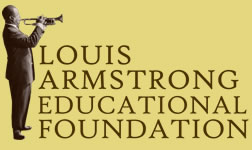
Louis Armstrong Biography
Louis Armstrong’s achievements are remarkable. During his career, he:
- Developed a way of playing jazz, as an instrumentalist and a vocalist, which has had an impact on all musicians to follow.
- Recorded hit songs for five decades, and his music is still heard today on television and radio and in films.
- Wrote two autobiographies, more than ten magazine articles, hundreds of pages of memoirs, and thousands of letters.
- Was the only Black Jazz musician to publicly speak out against school segregation in 1957.
- So popular that warring sides in the Democratic Republic of the Congo in Central Africa temporarily stopped fighting in 1960 to attend an Armstrong concert.
- Appeared in more than thirty films (over twenty were full-length features) as a gifted actor with superb comic timing and an unabashed joy of life.
- Composed dozens of songs that have become jazz standards.
- Performed an average of 300 concerts each year, with his frequent tours to all parts of the world earning him the nickname “Ambassador Satch,” and became one of the first great celebrities of the twentieth century.
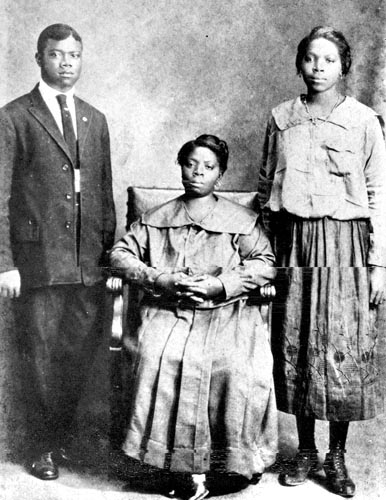
Louis Armstrong’s Life in Letters, Music and Art
Step inside the mind of one of America’s great virtuosos, thanks to a vast archive of his personal writings, home recordings and artistic collages.
Louis Armstrong in his den in 1958. In the background: a rug in the guest bathroom at the Louis Armstrong House Museum in Queens. Credit... Charles Graham, via Louis Armstrong Archive; Nathan Bajar for The New York Times
Supported by
By Giovanni Russonello
Photographs by Nathan Bajar
- Nov. 16, 2018
Behind his blistering trumpet solos, revolutionary vocal improvising and exuberant stage persona, how did Louis Armstrong see himself? What was it like to be the first pop virtuoso of the recorded era — the man whose earliest releases set the tune for America’s love affair with modern black music, and who went on to become one of history’s most famous entertainers?
Those questions aren’t rhetorical. There’s actually a deep well of resources on hand to help answer them. For his entire adult life, away from the spotlight, Armstrong amassed a huge trove of personal writings, recordings and artifacts. But until this month, you would have had to travel far into central Queens to find them. Now anyone can access them. Thanks to a $3 million grant from the Fund II Foundation — run by Robert F. Smith, the wealthiest African-American — the Louis Armstrong House Museum has digitized the entire collection he left behind and made it available to the public .
Armstrong wrote hundreds of pages of memoir, commentary and jokes throughout his life, and sent thousands of letters. He made collages and scrapbooks by the score. Over the final two decades of his life, he recorded himself to reel-to-reel tapes constantly, capturing everything from casual conversations to the modern music he was listening to.

Armstrong Plays Along With a Ray Martino Recording
All told, Armstrong’s is not just one of the most well documented private lives of any American artist. It’s one of the most creatively documented lives, too.
“Posterity drove him to write manuscripts and make tapes and catalog everything,” said Ricky Riccardi, the director of research collections at the Louis Armstrong House Museum and a noted Armstrong scholar. “He was just completely aware of his importance and wanting to be in control of his own story.”
And it wasn’t just posterity. The same things that drove him as a performer — faith in unfettered communication, an irreverent approach to the strictures of language, the desire to wrap all of American culture in his embrace — course through his writings, collages and home recordings.
Armstrong had been largely responsible for shaping jazz into the worldly, youth-driven music it became in the 1930s. He emerged as a symbol of racial pride, crossing Tin Pan Alley gentility with street patois, and sometimes singing directly about black frustrations . But as his career went on, his grinning stage persona — an expansion on the minstrel shows and New Orleans cabarets of his youth — fell out of step with most African-American listeners’ tastes. (“I loved the way Louis played trumpet, man, but I hated the way he had to grin in order to get over with some tired white folks,” Miles Davis wrote in his autobiography.)
With jazz’s identity solidifying as an art music in the 1950s, Armstrong became especially unfashionable to the critical establishment. The autumnal hits he scored in the mid-1960s, “Hello, Dolly!” and “What a Wonderful World,” seemed only to confirm the media consensus that the times had passed him by.
But these archives contain the tools for a better understanding of Armstrong: as idiosyncratic an artist as any, one whose creative instincts only grew deeper and broader over time.
In part, we see a man attuned to race and politics, who took his role seriously as a global ambassador for American culture and kept a close eye on the achievements of fellow African-Americans. When he spoke out against school segregation in Little Rock, Ark., in 1957, he surprised the nation. Some activists said it was too little, too late. The archive, however, shows that he considered it both a proud moment in his career and wholly of a piece with his life up to that point. In the collection is a telegram he wrote to President Dwight Eisenhower on the day Eisenhower announced he would be sending Army troops into Little Rock, urging him “to take those little Negro children personally into Central High School along with your marvelous troops.”
And as solicitous as he was, Armstrong was unwilling to let critical judgments define him. He kept a close eye on reviews, but he wrote acerbically about music critics and sometimes taped his interviews with them — perhaps for evidence, in case they misreported something. On one tape, from 1959, he barks at a journalist after being asked about changes afoot in jazz. “I just live what I play, and I can’t vouch for the other fellow. As long as I feel and hit the notes and I’ve got my own audience, then no critic in the world can tell me how I should play my horn,” he says.
Armstrong Looking at Us Looking at Him
The royal theater coal story.
Raised in New Orleans, Armstrong came to fame in his early 20s after joining King Oliver’s Creole Jazz Band in Chicago; his early recordings as a leader, with his Hot Five and Hot Seven, established jazz as a soloist’s music, and made him one of the first pop musicians of the radio era. By the 1940s and ’50s he was regularly included on lists of the most admired Americans.
Starting in his 20s, Armstrong frequently clipped newspaper articles about himself and bundled them into scrapbooks. The books began as a tool to convince club owners of his legitimacy, but they turned into a historical record. The dozens of scrapbook binders contained in the archive are a window into his self-image as a celebrity: Armstrong looking at us looking at him.
Armstrong began his career as an idol to many African-Americans. Watch the well-circulated video clip of him performing in Copenhagen in 1933 — bountiful and aggressive as he scats over “Dinah,” then carves his way through “Tiger Rag” with a sweltering trumpet solo — and you’ll get why. But as time wore on, many younger people, particularly musicians of the bebop generation, expressed misgivings about his genuflecting stage persona.
Armstrong’s scrapbooks make it clear that he kept a close eye on how he was perceived, as an artist and as a black statesman. When he traveled to Baltimore in the winter of 1931, he donated 300 bags of coal to residents of a needy black neighborhood, and privately saved the news clipping from The Baltimore Afro-American . When his band was arrested in Arkansas simply for traveling in the same bus as its white manager, he saved the article reporting it .
And when a blatantly racist British critic referred to him as “Mr. Ugly” the following year (“He looks, and behaves, like an untrained gorilla,” the article read), Armstrong kept a copy of that too. Reading what arts journalism was like in the late ’20s and ’30s, it becomes obvious how narrow the berth was for a public figure like Armstrong to emerge onto the national stage.
Musical Originality Matched in His Written Words
Armstrong sums up his life.
Armstrong wrote constantly — mostly letters and short stories about his life, but also in the form of limericks and pages-long jokes. He wrote in a galloping, oddly punctuated style, treating literature almost as an outsider art. Commas turned into apostrophes; jive talk collided with standard English; words were underlined all over. His musical originality is matched on the page.
When Armstrong joined King Oliver’s famed band, he brought along a typewriter. By 1936, when he was in his mid-30s, he had already published an autobiography. Over the course of his career he wrote more than 10,000 letters to fans , hundreds of pages of personal memoirs and enough lengthy jokes to fill an entire book.
In 1969 and ’70, with his health failing, Armstrong set about writing a long essay about his relationship with the Karnofskys, a Jewish family in New Orleans. When he was 7, he worked as a servant in their house, and they recognized his musical talent early, advancing him a small amount of money to buy his first cornet.
In this essay, which stretches on for 77 pages, Armstrong enshrines a number of other elements of his personal mythology. He reports his birthday as July 4, 1900, an apocryphal but symbolic date he was fond of using. And he describes the importance of the Storyville neighborhood where he was raised, and where much of early jazz was developed.
Just months after he wrote this piece, he died in his sleep at age 69. This story would be collected in a posthumous book, “ Louis Armstrong, in His Own Words, ” that featured essays from across his career, many of which are included in the Armstrong archive in their original, handwritten form.
Making His Own World, With Scissors and Tape
Armstrong on making collages.
Armstrong’s creative hobbies outside writing were less easily wrangled for posterity or publication. One example: the hundreds of collages that he made over the course of his life, cutting out and combining photographs, illustrations and text.
Starting in the early 1950s, few pieces of paper were safe from the blade of Armstrong’s scissors: magazines, risqué photographs, even a Christmas card from Richard Nixon wound up cut and collaged. Most of the time, he taped his collages onto reel-to-reel tape boxes; they were purely decorative. Elsewhere, he turned larger pieces of paper into what amounted to a personal hall of fame.
In one such collage, he crammed a page with almost a dozen photos of Jackie Robinson. On another, Duke Ellington and Kermit Parker, the first black man to run for governor as a Democrat in Louisiana, gaze toward each other from across the page.
And on the collage above, a photograph of King Oliver is pasted inside an image of Armstrong’s head, as if to make clear how much Armstrong felt he owed to Oliver. To their left are two other trumpeters: Bix Beiderbecke, a prominent jazz star of the 1920s, and Bunny Berigan, who drew heavily from Armstrong’s influence, both as a trumpeter and a vocalist. Other musicians pictured include Duke Ellington, the R&B vocalist Ruth Brown, and Big Sid Catlett, an influential early drummer who played with Armstrong’s big band at the height of its popularity.
In a far corner of the image, Franklin Delano Roosevelt, who had been president around the time when most of these musicians were stars, looks on.
The Once-Reluctant King of Queens
At home in corona.
When Armstrong died in 1971, his wife, Lucille, ensured that the house they shared in Corona, Queens — the place where he recorded his tapes, made collages and wrote his manifold letters and notes — remained exactly as he had left it.
At first, Armstrong didn’t want the house. But Lucille bought it in 1943, the year after they married, while he was on a lengthy tour. He eventually fell in love with the narrow two-story brick home, and with the working-class block into which it was tucked. Armstrong — whose four marriages never resulted in a child — proudly became an avuncular presence on the block, and bragged in a 1971 manuscript that he had watched three generations grow up around him. Years later, when Lucille eventually wanted to upgrade, he insisted they stay. So she made improvements. The ornate, Fifth Avenue-rate bathroom is a prime example. And the “Throne,” as Armstrong called it in his writing, was of prime import.
Armstrong took health and diet very seriously, partly because of having been raised by a single mother who focused, for lack of a doctor, on keeping her children healthy with natural remedies. After Lucille introduced him to Swiss Kriss, an herbal laxative, he became a zealous proponent and offered his endorsement for free. The couple wrote a diet plan that called for regular consumption of Swiss Kriss, and they circulated it among friends and fans along with a comical photo of Armstrong seated on his decked-out Queens toilet, with his “Satchmo-Slogan” printed below: “Leave it All Behind Ya .”
On the Record
Listening to caruso.
Starting in December 1950, Armstrong used a tape recorder to capture casual conversations, ambient road hangouts, interviews with journalists, radio broadcasts he liked and more. Most often, though, he would simply record his shellac and vinyl discs to tape, consolidating the music and making it easier to carry. He kept careful documentation of the track lists, and together the tapes and their accompanying lists provide a revealing glimpse into his broad music tastes.
Ever the careful documenter, Armstrong wrote out a playlist anytime he recorded music to tape — whether it was a recording of his own concert, a dub of an entire album or a more piecemeal mixtape.
The range of his listening is striking. He was as likely to listen to the Beatles as he was to Rachmaninoff. On one playlist, the old vaudeville singer Al Jolson and Miles Davis butt up against each other. “The man was obsessed with all kinds of music,” Riccardi said. “Anywhere he’d go — if he’d go to South America, he’d bring back South-American records. If he went to Africa, he’d bring back African records. He’d go to record stores everywhere.”
On a disc marked “Reel 24,” he is listening mostly to the bebop musicians that had succeeded him in the jazz spotlight of the 1940s and ’50s. On the audio of the tape itself, you can hear him announcing the tunes like a radio D.J.
After that tape plays, Armstrong introduces another: a bootleg recording of a jam session at Minton’s, the venue where bebop was born. After he plays it, he expresses approval. “Cats jumpin’, man,” he says, apparently unperturbed by the beboppers’ sometimes-ambivalent relationship to his own legacy. Later on, he jumps to a track of his own, “Among My Souvenirs.” In the handwritten playlist, Armstrong closely notates each turn in the tape, including the moment when he pauses to mention the children playing outside.
These are the children that Armstrong said he was thinking of when he sang his most famous song, “What a Wonderful World.” Here we have their very voices, documented for all time.
Produced by Jolie Ruben and Josephine Sedgwick.
Find the Right Soundtrack for You
Trying to expand your musical horizons take a listen to something new..
Beyoncé’s “Cowboy Carter” is a vivid mission statement. Let’s discuss !
Peter Brown , one of the Beatles’ closest confidants, tells all (again).
Alice Coltrane’s explosive Carnegie concert and 7 more new songs on the Playlist .
Pedal Steel Noah ’s covers charm fans online. Up next? His own songs.
5 minutes that will make you love Shirley Horn .
Advertisement

Louis Armstrong
- Born August 4 , 1901 · New Orleans, Louisiana, USA
- Died July 6 , 1971 · New York City, New York, USA (heart attack)
- Birth name Louis Daniel Armstrong
- The King of the Jazz Trumpet
- Height 5′ 5¾″ (1.67 m)
- Louis Armstrong grew up poor in a single-parent household. He was 13 when he celebrated the New Year by running out on the street and firing a pistol that belonged to the current man in his mother's life. At the Colored Waifs Home for Boys, he learned to play the bugle and the clarinet and joined the home's brass band. They played at socials, picnics and funerals for a small fee. At 18 he got a job in the Kid Ory Band in New Orleans. Four years later, in 1922, he went to Chicago, where he played second coronet in the Creole Jazz Band. He made his first recordings with that band in 1923. In 1929 Armstrong appeared on Broadway in "Hot Chocolates", in which he introduced Fats Waller 's "Ain't Misbehavin', his first popular song hit. He made a tour of Europe in 1932. During a command performance for King George V , he forgot he had been told that performers were not to refer to members of the royal family while playing for them. Just before picking up his trumpet for a really hot number, he announced: "This one's for you, Rex." - IMDb Mini Biography By: Dale O'Connor <[email protected]>
- Louis Armstrong is an American trumpeter, composer, vocalist, and actor who was among the most influential figures in jazz. His career spanned five decades, from the 1920s to the 1960s, and different eras in the history of jazz. In 2017, he was inducted into the Rhythm & Blues Hall of Fame. Armstrong was born and raised in New Orleans. Coming to prominence in the 1920s as an inventive trumpet and cornet player, Armstrong was a foundational influence in jazz, shifting the focus of the music from collective improvisation to solo performance. Around 1922, he followed his mentor, Joe Oliver , to Chicago to play in the Kid Ory's Creole Jazz Band . In Chicago, he spent time with other popular jazz musicians, reconnecting with his friend Bix Beiderbecke and spending time with Hoagy Carmichael and Lil Hardin . He earned a reputation at 'cutting contests', and relocated to New York in order to join Fletcher Henderson 's band. With his instantly recognizable rich, gravelly voice, Armstrong was also an influential singer and skillful improviser, bending the lyrics and melody of a song. He was also skilled at scat singing. Armstrong is renowned for his charismatic stage presence and voice as well as his trumpet playing. By the end of Armstrong's career in the 1960s, his influence had spread to popular music in general. - IMDb Mini Biography By: Tango Papa
- Spouses Lucille Wilson (October 12, 1942 - July 6, 1971) (his death) Alpha Smith (October 11, 1938 - 1942) (divorced) Lil Armstrong (February 5, 1924 - 1938) (divorced) Daisy Parker (March 24, 1919 - December 18, 1923) (divorced)
- Distinctive gravelly singing voice
- His famous blue suit with a white handkerchief
- His strong New Orleans accent
- His iconic, scat singing style
- The slang terms "cat" meaning a man about town and "chops" meaning a musician's playing ability were first coined by him.
- For most of his life, Louis Armstrong always gave July 4, 1900, as his birthdate, possibly because it was easy to remember. In all likelihood, he probably believed it himself. It wasn't until many years after his death that a birth record was found confirming the correct date as August 4, 1901.
- Refused to go a State Department-sponsored concert tour of the Soviet Union in 1959 because he felt the administration of President Dwight D. Eisenhower wasn't doing enough to promote civil rights legislation.
- He was laid to rest at the Flushing Cemetery, Section 9 in Flushing, Queens, New York City not too far from his home in Corona, Queens. His tombstone is a red granite, emblazoned simply "Satchmo" Louis Armstrong with a beautiful white trumpet figure laden on top. Buried with him is his last of four wives, Lucille Armstrong who died in 1983.
- Posthumously inducted into the Rock and Roll Hall of Fame (1990) (under the category Early Influence).
- I never tried to prove nothing, just wanted to give a good show. My life has always been my music, it's always come first, but the music ain't worth nothing if you can't lay it on the public. The main thing is to live for that audience, 'cause what you're there for is to please the people.
- All music is folk music. I ain't never heard no horse sing a song.
- What is jazz? Man, if you have to ask you'll never know.
- There's some folks, that, if they don't know, you can't tell 'em.
- If it wasn't for jazz, there wouldn't be no rock and roll.
Contribute to this page
- Learn more about contributing
More from this person
- View agent, publicist, legal and company contact details on IMDbPro

More to explore

Recently viewed
World History Edu
- Black History / U.S. History
Louis Armstrong: History & Major Accomplishments
by World History Edu · September 29, 2021
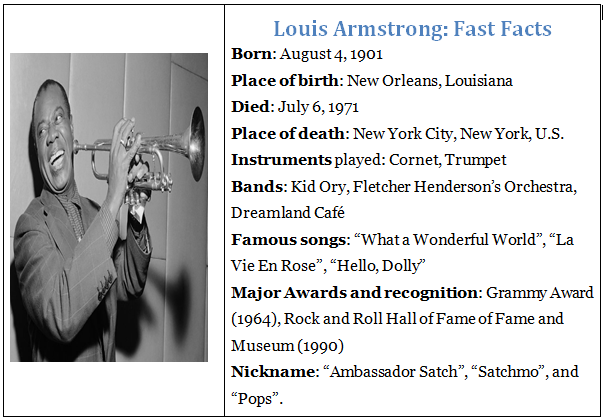
Louis Armstrong – history and achievements
Louis Armstrong (born Aug. 4, 1901, New Orleans, Louisiana—died July 6, 1971, New York City, New York), American jazz artist who is unanimously considered as the greatest jazz player in history. He is also noted for his masterpieces like “What a Wonderful World”, “Star Dust”, and “Hello, Dolly!”. His version of “Hello, Dolly!” received an induction into the Grammy Hall of Fame in 2001.
Armstrong could simply do it all; he was an all-round entertainer: a great singer, bandleader, actor, and comedian.
Although on record, Louis Armstrong’s date of birth is in 1901, the jazz artist usually claimed that he was born in 1900. His full name was Louis Daniel Armstrong.
His father, a factory worker, bailed out on the family a few months after the birth of Louis Armstrong. As a result of the dire financial situation, his mother intermittently made a living as a prostitute. Armstrong was left in the care of his maternal grandmother until he was 5 years old.
Louis Armstrong left school at an early age, probably in his fifth grade. This decision of his was necessitated by his family’s poor finances, as he had to work to supplement his family’s income. He worked as a delivery boy, supplying coal, and also selling newspapers. One of his employers, a Jewish family, were the ones who encouraged him to sing.
Louis Armstrong was born in an era when jazz music was relatively in its nascent years. As a kid, his passion for music was evident for everyone to see. He was a key member of a local boys’ quartet in New Orleans. Simply put, jazz music was Armstrong’s go-to, his escape, and his saving grace.

He was born into abject poverty into a family that lived in New Orleans, Louisiana. To shore up his family’s meager income, the young Armstrong took up menial jobs.
Louis Armstrong’s troubling childhood
Exacerbated by the dire financial situation of his family, Louis Armstrong’s teenage years were extremely rough. By the time he was 13 years of age, this future jazz genius had got caught up with a bad group of friends. After firing his stepfather’s gun in the air on New Year’s Eve in 1912, he was arrested. For his rogue behavior the teenager was placed in the Colored Waifs Home for Boys.
Kid Ory band
The reform center was a blessing in disguise as it was at that very place that Armstrong began honing his skills in music. He is said to have begun mastering the cornet. With the help of his local band, Armstrong blossomed into a very good musician.
He religiously listened to early jazz musicians and pioneers like King Oliver, a famous New Orleans cornetist. The more he played with his local band as well as marching bands, the better his skills became.
It did not take too long for Armstrong to rise among jazz players in New Orleans. In 1918, he received a call up into the Kid Ory band, succeeding his role model King Oliver.
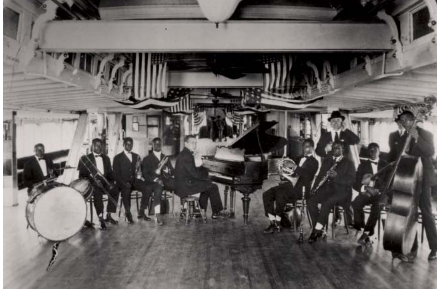
In his early career, Armstrong also had a number of showings in local marching bands in New Orleans. by his mid-20s, he was performing with a number of prominent jazz bands. | Image: Armstrong was a member of Fate Marable’s New Orleans Band in 1918, here on board the S.S. Sidney
Armstrong’s meteoric rise
As time went on Armstrong’s musical prowess had begun to catch the attention of many key stakeholders in the industry. One of such personalities was Armstrong’s role model King Oliver, who by then was dazzling patrons of jazz music in Chicago.
Oliver invited Armstrong to his band Creole Jazz Band as a second cornetist. The young musician had the pleasure of working alongside renowned artists Johnny Dodds, Lil Hardin, and Johnny Dodds.
Along with King Oliver, Armstrong, who played second cornet, helped transform the fortunes of the band.
Solo career and records
Receiving critical acclaim for his cornet duet passages (known as “breaks”), Armstrong would go on to make his first solo records “Tears” and “Chimes Blues” (1923). His band mate and later wife Lil Hardin assisted him in composing those songs.
After gaining enough credibility in the industry, Armstrong decided to go solo. He had a few collaborations with New York City -based bandleader and pianist Fletcher Henderson (1897-1952).
A clash of cultures between Armstrong, a jazz artist with strong southern background, and Henderson’s New York City-based band resulted in Armstrong parting ways with the band in 1925.
Louis Armstrong and his Hot Five
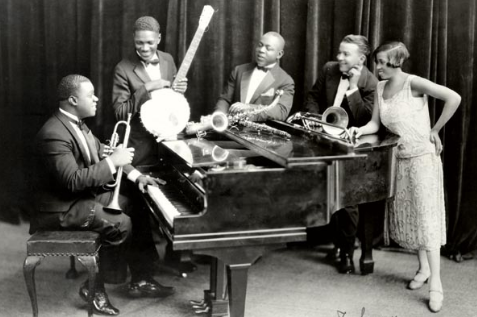
Louis Armstrong and the Hot Five (1926) | Image
From 1925 to around 1928, he was signed on to OKeh Records. He came out with more than 60 records in that period while working with his band Louis Armstrong and his Hot Five . The band later became the Hot Seven. Their records rank up there as some of the most important in jazz music history.
Some of his famous solos include “Cornet Chop Suey” and “Potato Head Blues”. His swinging phrases, high notes and rhythmic choices were some of most endearing qualities.
He is also credited with popularizing “scat singing” beginning around 1926 with his “Heebie Jeebies” record. In 1926, he switched from cornet to trumpet.
Armstrong and Earl Hines
Around the late 1920s, he collaborated with Earl Hines, a Pittsburg pianist who was a long admirer of Armstrong. Hines incorporated Armstrong’s style into his craft on so many occasions.
Armstrong and Hines collaborated to produce some of the greatest jazz songs in history, including 1928 songs like “Weather Bird” and “West End Blues”.
Major Achievements of Louis Armstrong
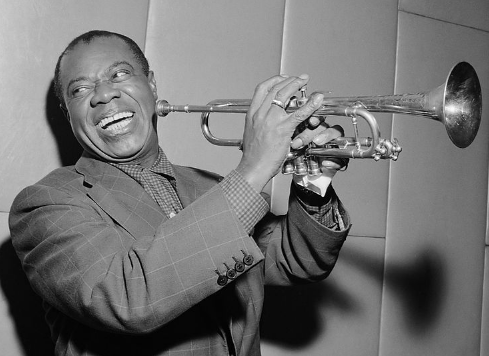
Armstrong is praised as the first prominent jazz soloist
Beginning around the mid-1920s, Armstrong’s music career took an even more upward trajectory when he started playing in large orchestras in Chicago. It was in Chicago that he recorded his first few music hits such as the Armstrong Hot Five and Hot Seven.
Those records helped establish him as the most prominent jazz soloist at the time. His musical prowess, including his style and technique, set him miles apart from other upcoming jazz soloist in New Orleans.
Some of the great works that he came out with around that time include hits like “Wild Man Blues”, Hotter than That”, and Potato Head Blues”.
Developed a technique that was close to flawless
Louis Armstrong holds the honor as the greatest jazz artist of all time simply because he had a technique was immaculately close to flawless. Playing the trumpet, Armstrong took the jazz music genre by storm in the late 1920s. He was praised for his sharp sense of harmony as well as his ability to time his inflections. He was no ordinary trumpeter, dazzling jazz patrons with his on stage performance which complemented his well-crafted melodies. Those techniques of his were some of the reasons why jazz music became popular in America.
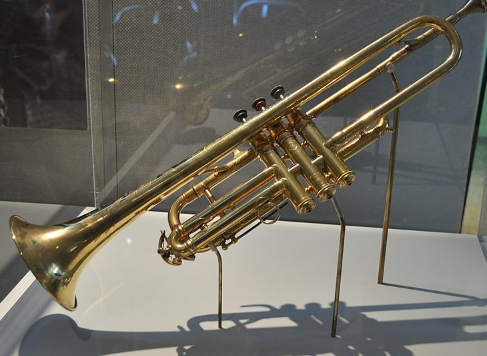
Jazz genius Louis Armstrong was explosive on stage, opting to hold nothing back. By the late 1920s, his solo career had lifted off, making him the most famous jazz artist of the era. He secured a number of tours across the U.S. as well in many European countries. | Selmer trumpet, given as a gift by King George V of the United Kingdom to Louis Armstrong in 1933
He had tremendous influence on jazz artists and other musicians that followed
Jazz artist and genius Armstrong was important in the transforming jazz as novelty art form into a full-fledged music genre. He paid careful attention to his technique, which in turn allowed him to fully express his emotions and be more sensitive on stage. It’s been noted that his phrasing was emulated by the likes of Bud Freeman and Coleman Hawkins. Similarly, his swing-style when playing the trumpet influenced majority of jazz horn players. Great musicians like Billie Holiday and Bing Crosby were inspired by Armstrong’s supple vocal style.
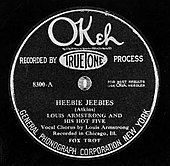
Armstrong was most known for his distinct vocals and expressive trumpet style. He also had an endearing and charismatic presence on stage. Louis Armstrong influenced countless musicians not just in the U.S. but across the world. He influenced musicians like Bing Crosby, Frank Sinatra, Coleman Hawkins, Bud Freeman, and Ella Fitzgerald. | Image: “Heebie Jeebies” by Louis Armstrong and his Hot Five
Louis Armstrong made a big splash in other entertainment genres
In addition to performing in big bands and going on nonstop stops across the world, Armstrong was also noted for his acting. It’s been estimated that he featured in close to three dozen films. His last film appearance was in 1969 in Hello, Dolly! which was directed by Gene Kelly (1912-1996)
His good humor was just one of the reasons why he was endearing whenever he made radio and television appearances.
Films like Pennies from Heaven (1936), New Orleans (1947) and Hello , Dolly! (1969) are some of the reasons why many historians praise Louis Armstrong as an all-round entertainer and one of the greatest celebrities of the 20 th century.
Other notable accomplishments of Louis Armstrong
- For more than half a century, Louis Armstrong remained one of the most famous faces in the African-American community. His hit songs dominated the music industry, particularly the jazz landscape, in that period as well.
- His energy levels were simply off the charts. It’s been estimated that took up to 300 concerts each year. While on those nonstop global tours, he earned the nickname “Ambassador Satch”. Other nicknames of this jazz genius are “Satchmo” and “Pops”.
- He is credited with composing many masterpieces, i.e. jazz songs that are timeless and still continue to inspire modern artists.
- Louis Armstrong penned two very brilliant autobiographies: Swing That Music (1936) and Satchmo: My Life in New Orleans (1954). In addition to those works, he wrote many magazine articles.
- Louis Armstrong’s 1960 concert in the central African country of the Democratic Republic of the Congo caused two warring sides into a temporary cease fire.
- His popularity increased even further after his record label, OKeh Records, allowed him to cover pop songs of the day. Most notable examples of those songs include “I Can’t Give You Anything But Love” and “Body and Soul”.
Louis Armstrong’s significance and most famous songs
In 1936, he became the first African American jazz musician to write an autobiography. The book was titled Swing That Music . He is also the first African American celebrity to appear in a major Hollywood movie. The movie he appeared in was Pennies from Heaven (1936). In 1937, Louis Armstrong became the first African American to host a nationally sponsored radio show.
Louis Armstrong’s illustrious career saw him secure nineteen “Top Ten” records. Some of those records were “Stardust”, “Dream a Little Dream of Me”, “You Rascal You”, “What a Wonderful World”, and “Stompin’ at the Savoy”. His song “We Have All the Time in the World” attained No. 3 in the UK in 1994 after it was re-released.
His song “Hello, Dolly!” (1964), which topped the Billboard Hot 100 chart, even beating The Beatles, is testimony to just how influential he was in the music industry.
Louis Armstrong and the Little Rock Nine
Initially, Armstrong was not a known figure in the civil rights movement. As a matter of fact, he was criticized for his inability to use his fame and reputation to condemn the deplorable civil right situation in the U.S. at the time.
Louis Armstrong perhaps had had enough of the situation after seeing Arkansas governor Orval Faubus use the National Guard to prevent African American students (i.e. the Little Rock Nine) from accessing a public school (Little rock Central High School). The jazz icon went all berserk and slammed the U.S. government (then during the presidency of Dwight D. Eisenhower ) for its continued racial segregation in public schools. Armstrong was praised for his bold move considering the fact that he was perhaps the only African-American jazz artist to criticize racial segregation in schools.
More Louis Armstrong facts
In his movie career, he made appearances alongside topnotch actors like Martha Raye and Mae West. Here are a few more notable facts about Louis Armstrong:
- Armstrong was described as a very down to earth man despite his fame and riches. He maintained a house in a working-class neighborhood for quite a long time.
- The neighborhood (i.e. in New Orleans, Louisiana) that Armstrong grew up in as child was so deplorable that it was given the nickname “The Battlefield”.
- It’s been claimed that he was sterile as he had no children in all four marriages of his. He and his fourth and final wife Lucille Wilson tried for years to have children, but had no success.
- Armstrong’s “Hello, Dolly!” – title number for a Broadway show – was released in 1964. The song went top of the pop music charts in May 1964. In 2001, Armstrong’s version of the song was inducted into the Grammy Hall of Fame.
- He was one of the few artists from the West who could penetrate the “Iron Curtain” of the Soviet Union, with his performances in East Berlin and Czechoslovakia in 1965.
- During his tour of Europe in 1933, he lips became sore due to his blowing of high notes.
- Armstrong collaborated with artists like Sidney Bechet and Bessie Smith.
“What a Wonderful World”
At the time that Louis Armstrong’s “What a Wonderful World” was released (In 1967), it did not receive much acclaim probably because the jazz musician’s record company did not promote it that much. Regardless, the song, a ballad with no trumpet, attained No. 1 spots in many countries around the world, including the UK and South Africa.
Interlaced with angelic voices, Armstrong’s “What a wonderful World” is one of his most-beloved songs. The song’s lyrics contain a theme of optimism by entreating the listener to appreciate the goodness of life and all its beauty and color.
The song, which featured in Robin Williams’ 1986 film Good Morning, Vietnam, has been covered by many artists, including American singer Roy Clark, Canadian singer Céline Dion, and British musician Rod Stewart, among others.How did Louis Armstrong die?
Towards the later part of the 1960s, Louis Armstrong’s health had begun to deteriorate as he battled heart and kidney problems. Those health issues forced him to stop performing in 1969. That same year, tragedy struck when his long-time manager Joe Glaser died. Armstrong tried to marshal a few performances here and there, but it was obvious that he did not have the stamina to keep on going. Years of unhealthy lifestyle had caught up with him.
On July 6, 1971, the jazz legend died in his sleep in his home in Corona, Queens, New York. His home was converted into a National Historic Landmark in 1977. The building also houses the Louis Armstrong House Museum, which receives thousands of visitors annually.
Louis Armstrong’s spouses
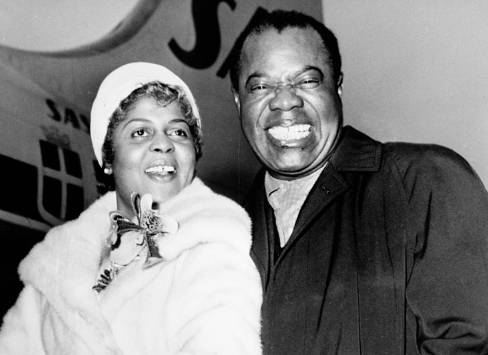
Louise Armstrong married four times. His last was to Lucille Wilson in 1942. The marriage lasted until his death. Image: Armstrong and his fourth wife Lucille Wilson in 1960s
His first marriage (in 1918) was to a Red-light district worker called Daisy Parker. No sooner had the marriage begun than did it get hit by irreconcilable differences and accusations of violence. He said to have adopted a three-year-old boy called Clarence, who was his second cousin. Armstrong took good care of Clarence, a child who suffered brain injuries at an early age.
He married his band mate pianist Lil Hardin in 1924. Armstrong and Hardin separated in 1931. The divorce was finalized in 1938. It was Hardin who encouraged Armstrong to break away from his mentor King Oliver’s band in Chicago.
Armstrong married Alpha Smith. Similar to his first two marriages, this marriage was an unhappy one and divorced in 1942.
In 1942, he married Lucille Wilson, a club dancer. He and Wilson made residence at his Queens, New York City home from 1943 to 1971 when he died.
Tags: 20th-century American Jazz singers African-American Singers Jazz music Louis Armstrong New Orleans-U.S. Scat singers
You may also like...

Texas Flag: Meaning, History and Facts
July 27, 2019

How Ellis Island became America’s busiest immigration center
March 17, 2023
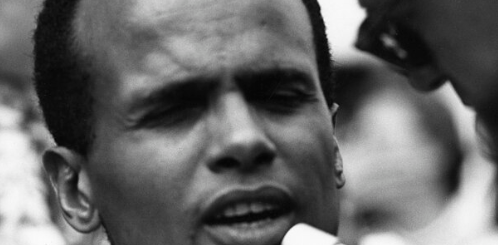
Harry Belafonte: Life and Major Accomplishments
October 9, 2023
- Pingbacks 0
As a teenager in the UK I went to see a live concert featuring Louis Armstrong and the All Stars in the Empire Pool Wembley which has since change its name to the Wembley Arena in England in the 1950’s. I once saw on TV some video footage of the concert but can’t trace any videos or references of this concert. Can you please help me locate anything relevant?
Leave a Reply Cancel reply
Your email address will not be published. Required fields are marked *
Save my name, email, and website in this browser for the next time I comment.
- Next story Henry III of England: History, Family Tree, Reign, Achievements, & Death
- Previous story Isaac Newton’s Greatest Achievements
- Popular Posts
- Recent Posts

How did people cope during heat waves before the invention of air conditioning?

History of Alexios I Komnenos: How did the Byzantine Emperor Establish the Last Great Imperial Dynasty?

Brief history of South Africa and why it has three capital cities

Difference between Julian Calendar and Gregorian Calendar

History of South Korea and how it became a developed country

Greatest African Leaders of all Time

Queen Elizabeth II: 10 Major Achievements

Donald Trump’s Educational Background

Donald Trump: 10 Most Significant Achievements

8 Most Important Achievements of John F. Kennedy

Odin in Norse Mythology: Origin Story, Meaning and Symbols

Ragnar Lothbrok – History, Facts & Legendary Achievements

9 Great Achievements of Queen Victoria

12 Most Influential Presidents of the United States

Most Ruthless African Dictators of All Time

Kwame Nkrumah: History, Major Facts & 10 Memorable Achievements

Greek God Hermes: Myths, Powers and Early Portrayals

8 Major Achievements of Rosa Parks

How did Captain James Cook die?

10 Most Famous Pharaohs of Egypt

Kamala Harris: 10 Major Achievements

The Exact Relationship between Elizabeth II and Elizabeth I

Poseidon: Myths and Facts about the Greek God of the Sea

Nile River: Location, Importance & Major Facts

Importance and Major Facts about Magna Carta
- Adolf Hitler Alexander the Great American Civil War Ancient Egyptian gods Ancient Egyptian religion Aphrodite Apollo Athena Athens Black history Carthage China Civil Rights Movement Constantine the Great Constantinople Egypt England France Germany Ghana Hera Horus India Isis John Adams Julius Caesar Loki Military Generals Military History Nobel Peace Prize Odin Osiris Pan-Africanism Queen Elizabeth I Ra Ragnarök Religion Set (Seth) Soviet Union Thor Timeline Women’s History World War I World War II Zeus
- World Biography
Louis Armstrong Biography
Born: August 4, 1901 New Orleans, Louisiana Died: July 6, 1971 New York, New York African American jazz musician and singer
L ouis Armstrong was a famous jazz trumpet player and singer. He is regarded as one of the most important and influential musicians in the history of jazz music.
Louis Daniel Armstrong was born in New Orleans on August 4, 1901. He was one of two children born to Willie Armstrong, a turpentine worker, and Mary Ann Armstrong, whose grandparents had been slaves. As a youngster, he sang on the streets with friends. His parents separated when he was five. He lived with his sister, mother, and grandmother in a rundown area of New Orleans known as "the Battlefield" because of the gambling, drunkenness, fighting, and shooting that frequently occurred there.
In 1913 Armstrong was arrested for firing a gun into the air on New Year's Eve. He was sent to the Waif's Home (a reform school), where he took up the cornet (a trumpet-like instrument) and eventually played in a band. After his release he worked odd jobs and began performing with local groups. He was also befriended by Joe "King" Oliver, leader of the first great African American band to make records, who gave him trumpet lessons. Armstrong joined Oliver in Chicago, Illinois, in 1922, remaining there until 1924, when he went to New York City to play with Fletcher Henderson's band.
Jazz pioneer
When Armstrong returned to Chicago in the fall of 1925, he organized a band and began to record one of the greatest series in the history of jazz. These Hot Five and Hot Seven recordings show his skill and experimentation with the trumpet. In 1928 he started recording with drummer Zutty Singleton and pianist Earl Hines, the latter a musician whose skill matched Armstrong's. Many of the resulting records are masterpieces of detailed construction and adventurous rhythms. During these years Armstrong was working with big bands in Chicago clubs and theaters. His vocals, featured on most records after 1925, are an extension of his trumpet playing in their rhythmic liveliness and are delivered in a unique throaty style. He was also the inventor of scat singing (the random use of nonsense syllables), which originated after he dropped his sheet music while recording a song and could not remember the lyrics.
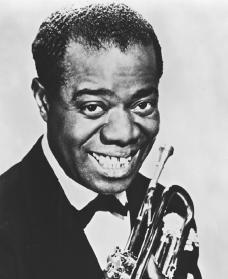
Later years
Armstrong continued to front big bands, often of lesser quality, until 1947, when the big-band era ended. He returned to leading a small group that, though it included first-class musicians at first, became a mere background for his talents over the years. During the 1930s Armstrong had achieved international fame, first touring Europe as a soloist and singer in 1932. After World War II (1939–45) and his 1948 trip to France, he became a constant world traveller. He journeyed through Europe, Africa, Japan, Australia, and South America. He also appeared in numerous films, the best of which was a documentary titled Satchmo the Great (1957).
The public had come to think of Louis Armstrong as a vaudeville entertainer (a light, often comic performer) in his later years—a fact reflected in much of his recorded output. But there were still occasions when he produced well-crafted, brilliant music. He died in New York City on July 6, 1971.
For More Information
Bergreen, Laurence. Louis Armstrong: An Extravagant Life. New York: Broadway Books, 1997.
Giddins, Gary. Satchmo. New York: Doubleday, 1988.
Jones, Max, and John Chilton. Louis: The Louis Armstrong Story 1900–1971. London: Studio Vista, 1971.
User Contributions:
Comment about this article, ask questions, or add new information about this topic:.
- History Classics
- Your Profile
- Find History on Facebook (Opens in a new window)
- Find History on Twitter (Opens in a new window)
- Find History on YouTube (Opens in a new window)
- Find History on Instagram (Opens in a new window)
- Find History on TikTok (Opens in a new window)
- This Day In History
- History Podcasts
- History Vault
9 Things You May Not Know About Louis Armstrong
By: Evan Andrews
Updated: June 1, 2023 | Original: August 4, 2016

1. A Jewish immigrant family helped him buy his first horn.

Armstrong was born on August 4, 1901, into a poverty-ridden section of New Orleans nicknamed “the Battlefield.” His father abandoned the family when Armstrong was a child, and his teenaged mother was often forced to resort to prostitution to make ends meet. Young Louis spent much of his boyhood in the care of his grandmother, but he also found a second home among the Karnofskys, a local Lithuanian-Jewish family who hired him to do odd jobs for their peddling business. The jazzman would later write that the Karnofskys treated him as though he were their own child, often giving him food and even loaning him money to buy his first instrument, a $5 cornet (he wouldn’t begin playing the trumpet until 1926). As a sign of his gratitude to his Jewish benefactors, Armstrong later took to wearing a Star of David pendant around his neck.
2. Armstrong first received musical training during a stint in juvenile detention.

Armstrong spent his youth singing on the street for spare change, but he didn’t receive any formal musical training until age 11, when he was arrested for firing a pistol in the street during a New Year’s Eve celebration. The crime earned him a stint in a detention facility called the Colored Waif’s Home for Boys, and it was there that Armstrong claimed, “me and music got married.” He spent his 18-month sentence learning how to play bugle and cornet from the Waif’s Home’s music teacher, Peter Davis, and eventually became a star performer in its brass band. Armstrong continued honing his skills in New Orleans’ honkytonks after his release, and in 1919, he landed a breakthrough gig with a riverboat band led by musician Fate Marable. “I do believe that my whole success goes back to that time I was arrested as a wayward boy,” he later wrote, “because then I had to quit running around and began to learn something. Most of all, I began to learn music.”
3. His wife helped jumpstart his solo career.

After leaving New Orleans in 1922, Armstrong spent three years playing in jazz ensembles in Chicago and Harlem. He was largely content to be a journeyman musician, but his second wife, a pianist named Lil Hardin, believed he was too talented not have his own band. In 1925, while Armstrong was performing in New York, Hardin went behind his back and inked a deal with Chicago’s Dreamland Café to make him a featured act. She even demanded that he be billed as “The World’s Greatest Trumpet Player.” Armstrong was hesitant at first, but it turned out to be the best move of his career. Only a few days after he arrived back in Chicago, OKeh Records allowed him to make his first recordings under his own name. Between 1925 and 1928, he and his backup bands, the Hot Five and Hot Seven, went on to cut several dozen records that introduced the world to his improvisational trumpet solos and trademark scat singing. The OKeh recordings would later play a key role in establishing Armstrong as a legendary figure in jazz. His marriage to Hardin, meanwhile, proved less successful—the couple divorced in 1938.
4. Armstrong was one of the first celebrities to be arrested for drug possession.
Armstrong made no secret of his fondness for marijuana , which he described as “a thousand times better than whiskey.” In 1930, when the drug was still not widely known, he and drummer Vic Berton were arrested after police caught them smoking a joint outside the Cotton Club in California. Armstrong served nine days in jail for the bust, but despite his brush with law, he continued using marijuana regularly for the rest of his life. “It makes you forget all the bad things that happen to a Negro,” he once said.
5. His playing style took a heavy toll on his lips.
Thanks to a relentless touring schedule and his penchant for hitting high Cs on the trumpet, Armstrong spent much of his career battling severe lip damage. He played with such force that he often split his lip wide open, and he suffered from painful scar tissue that a fellow musician once said made his lips look “as hard as a piece of wood.” Armstrong treated his lip callouses with a special salve or even removed them himself using a razor blade, but as the years passed, he began struggling to hit his signature high notes. The trumpeter was so famously hard on his “chops,” as he called them, that a certain type of lip condition is now commonly known as “Satchmo’s Syndrome.”
6. Armstrong famously criticized President Dwight D. Eisenhower over segregation.
Armstrong’s hesitancy to speak out against racism was a frequent bone of contention with his fellow black entertainers, some of whom branded him an “Uncle Tom.” In 1957, however, he famously let loose over segregation. At the time, a group of black students known as the “Little Rock Nine” were being prevented from attending an all-white high school in Arkansas. When asked about the crisis in an interview, Armstrong replied, “The way they are treating my people in the South, the government can go to hell.” He added that President Dwight D. Eisenhower was “two-faced” and had “no guts” for not stepping in, and declared that he would no longer play a U.S. government-sponsored tour of the Soviet Union.
The comments caused a sensation in the media. Some whites even called for boycotts of the trumpeter’s shows, but the controversy soon blew over after Eisenhower sent soldiers to desegregate the schools in Little Rock. “I feel the downtrodden situation the same as any other Negro,” Armstrong later said of his decision to speak out. “I think I have a right to get sore and say something about it.”
7. He served as a “musical ambassador” for the U.S. State Department.

During the height of the Cold War in the late 1950s, the U.S. State Department developed a program to send jazz musicians and other entertainers on goodwill tours to improve America’s image overseas. Armstrong was already known as “Ambassador Satch” for his concerts in far-flung corners of the globe, but in 1960, he became an official cultural diplomat after he took off on a three-month, State Department-sponsored trip across Africa. The trumpeter and his band, the All Stars, proceeded to take the continent by storm. “In Accra, Ghana, 100,000 natives went into a frenzied demonstration when he started to blow his horn,” the New York Times later wrote, “and in Léopoldville, tribesmen painted themselves ochre and violet and carried him into the city stadium on a canvas throne.” One of the most remarkable signs of Armstrong’s popularity came during his stopover in the Congo’s Katanga Province, where the two sides in a secession crisis called a one-day truce so they could watch him play. He would later joke that he had stopped a civil war.
8. At age 62, Armstrong surpassed The Beatles at the top of the pop charts.

In late-1963, Armstrong and his All Stars recorded the title track for an upcoming musical called “Hello, Dolly!” The trumpeter didn’t expect much from the tune, but when the show debuted on Broadway the following year, it became a runaway hit. By May, “Hello Dolly!” had soared to the top of the charts, displacing two songs by The Beatles, who were then at the height of their popularity. At age 62, Armstrong became the oldest musician in American history to have a number one song.
9. The song 'What a Wonderful World' was not a hit during his lifetime.

Armstrong is widely remembered for his rosy ballad “What a Wonderful World,” which he recorded in 1967, just four years before his death. But while the song performed well overseas, it was not well promoted in the United States and flopped upon its initial release. According to Armstrong biographer Terry Teachout, “What a Wonderful World” didn’t make a comeback until 1987, when it was included in the soundtrack of the Robin Williams film “Good Morning, Vietnam.” It was then reissued and shot to number 33 on the Billboard charts, and since then it’s become one of Armstrong’s signature tunes.

Sign up for Inside History
Get HISTORY’s most fascinating stories delivered to your inbox three times a week.
By submitting your information, you agree to receive emails from HISTORY and A+E Networks. You can opt out at any time. You must be 16 years or older and a resident of the United States.
More details : Privacy Notice | Terms of Use | Contact Us

IMAGES
VIDEO
COMMENTS
Louis Armstrong (born August 4, 1901, New Orleans, Louisiana, U.S.—died July 6, 1971, New York, New York) was the leading trumpeter and one of the most influential artists in jazz history.. Early life and career. Although Armstrong claimed to be born in 1900, various documents, notably a baptismal record, indicate that 1901 was his birth year.
Early life. Armstrong is believed to have been born in New Orleans on August 4, 1901, but the date has been heavily debated. Armstrong himself often claimed he was born on July 4, 1900. His parents were Mary Estelle "Mayann" Albert and William Armstrong.
Learn about the life and career of Louis Armstrong, an internationally famous jazz trumpeter, bandleader, and singer known for songs like "What a Wonderful World," "Hello, Dolly!," and "Star Dust." Find out his musical beginnings, achievements, challenges, and legacy in this comprehensive biography.
Learn about the life and legacy of Louis Armstrong, the legendary jazz musician and cultural ambassador, from his early years in New Orleans to his worldwide fame and achievements. Explore his musical influences, achievements, challenges, and legacy through his words and music.
Learn how Louis Armstrong, the legendary jazz musician and singer, changed the sound and style of jazz with his trumpet playing, scat singing and popular tunes. From his early years in New Orleans to his rise to fame in New York, discover how he influenced and inspired many other artists and genres of music.
Learn about the life and music of Louis Armstrong, the influential jazz trumpeter and singer who changed the landscape of jazz with his improvisations and style. Discover how he influenced many other artists, fought for social justice, and became an icon of American culture.
Louis Armstrong was born in a poor section of New Orleans known as "the Battlefield" on August 4, 1901. By the time of his death in 1971, the man known around the world as Satchmo was widely recognized as a founding father of jazz—a uniquely American art form. His influence as an artist and cultural icon is universal, unmatched, and very ...
Fast Facts: Louis Armstrong. Known For: World-famous trumpeter and entertainer; he was influential in the development of jazz and also appeared in more than 30 movies. Also Known As: Satchmo, Ambassador Satch. Born: August 4, 1901, in New Orleans. Parents: Mary Ann, William Armstrong. Died: July 6, 1971, in New York City.
Louis Armstrong, (born Aug. 4, 1901, New Orleans, La., U.S.—died July 6, 1971, New York, N.Y.), U.S. jazz trumpeter and singer. As a youth in New Orleans, he participated in marching, riverboat, and cabaret bands. A childhood nickname, Satchelmouth, was shortened to Satchmo and used throughout his life. In 1922 he moved to Chicago to join ...
A comprehensive overview of the life and career of Louis Armstrong, the first African American jazz trumpeter and singer, from his early years in New Orleans to his worldwide fame and legacy. Learn about his musical contributions, cultural impact, and personal style through various sources, including his own autobiographies, essays, and letters.
Louis as a teenager in New Orleans with his mother Mayann and sister Beatrice. Louis Armstrong and His Hot Five, 1926. Through the years, Louis entertained millions, from heads of state and royalty to the kids on his stoop in Corona. Despite his fame, he remained a humble man and lived a simple life in a working-class neighborhood.
With Lucille Armstrong in the background. When Armstrong died in 1971, his wife, Lucille, ensured that the house they shared in Corona, Queens — the place where he recorded his tapes, made ...
Louis Armstrong. Actor: High Society. Louis Armstrong grew up poor in a single-parent household. He was 13 when he celebrated the New Year by running out on the street and firing a pistol that belonged to the current man in his mother's life. At the Colored Waifs Home for Boys, he learned to play the bugle and the clarinet and joined the home's brass band. They played at socials, picnics...
Louis Armstrong - history and achievements. Louis Armstrong (born Aug. 4, 1901, New Orleans, Louisiana—died July 6, 1971, New York City, New York), American jazz artist who is unanimously considered as the greatest jazz player in history. He is also noted for his masterpieces like "What a Wonderful World", "Star Dust", and "Hello ...
Louis Armstrong Biography ; Louis Armstrong Biography. Born: August 4, 1901 New Orleans, Louisiana Died: July 6, 1971 New York, New York African American jazz musician and singer L ouis Armstrong was a famous jazz trumpet player and singer. He is regarded as one of the most important and influential musicians in the history of jazz music.
Armstrong recorded dozens of classics as a bandleader, trumpet player, sideman, and vocalist. Highlights of his career include: 1. "St. Louis Blues": Armstrong recorded multiple versions of "St. Louis Blues." Two of them, one sung by Bessie Smith in 1925 and one sung by Red Allen in 1929, were inducted into the Grammy Hall of Fame. 2.
Louis Armstrong, nicknamed "Satchmo," "Pops" and, later, "Ambassador Satch," was born in 1901 in New Orleans, Louisiana. An all-star virtuoso, he came to pro...
In the first episode of 5 Minute Biographies we take a look at the life of jazz legend, Louis ArmstrongRead more about Louis Armstrong in his own words at Am...
Louis Armstrong discography. Louis Armstrong (1901-1971), nicknamed Satchmo [1] or Pops, was an American trumpeter, composer, singer and occasional actor who was one of the most influential figures in jazz and in all of American popular music. His career spanned five decades, from the 1920s to the 1960s, and different eras in jazz.
1. A Jewish immigrant family helped him buy his first horn. Armstrong with his mother and sister Beatrice in New Orleans in 1921. Armstrong was born on August 4, 1901, into a poverty-ridden ...
Armstrong was an American trumpeter, composer, vocalist, and actor who was among the most influential figures in jazz. His career spanned five decades, from ...
Louis Daniel Armstrong (becenevén Satchmo; New Orleans, Louisiana, 1901. augusztus 4. - New York, New York, 1971. július 6.) Grammy-díjas amerikai dzsessz trombitás, énekes, zenekarvezető, a dzsessztörténet egyik legnagyobb és legismertebb alakja.
Louis Armstrong (surnommé « Dippermouth », « Satchmo », « Satch » (abréviation de satch el- mo uth , littéralement « bouche-sacoche ») ou « Pops ») né le 4 août 1901 à La Nouvelle-Orléans en Louisiane et mort le 6 juillet 1971 à New York , est un musicien et chanteur de jazz afro-américain , considéré comme un des jazzmen les plus emblématiques de l' histoire du jazz ...
12,738,847. Source: MSY [1] and FAA [2] Louis Armstrong New Orleans International Airport ( IATA: MSY, ICAO: KMSY, FAA LID: MSY) is an international airport under Class B airspace in Kenner city, Jefferson Parish parishes, Louisiana, United States. It is owned by the city of New Orleans and is 11 miles (18 km) west of downtown New Orleans. [3]